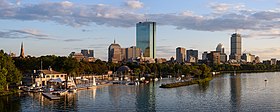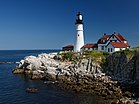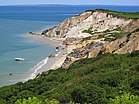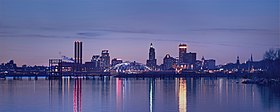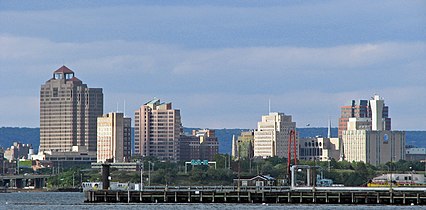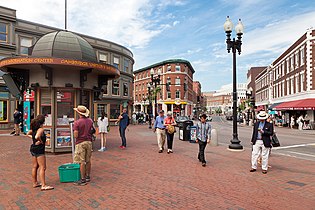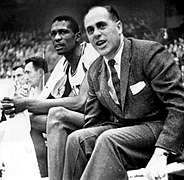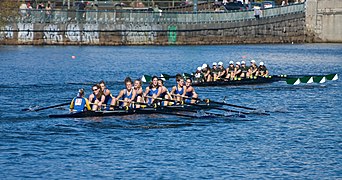New England
New England | |
|---|---|
|
Left-right from top:Bostonskyline,Portland Head LightinCape Elizabeth,thePresidential Range,Burlingtonskyline,Aquinnah,theConnecticut Rivervalley, skyline ofProvidence | |
 Flag(unofficial) | |
| Motto(s): None official. "An Appeal to Heaven"and"Nunquam libertas gratior extat"(Latinfor 'Never does liberty appear in a more gracious form') are commonde factomottos. | |
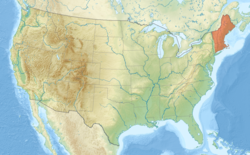 Location of New England (red) in the United States | |
 Location of New England (red) in North America | |
| Composition | |
| Largest metropolitan area | |
| Largest city | Boston |
| Area | |
| • Total | 71,987.59 sq mi (186,447.0 km2) |
| • Land | 62,688.4 sq mi (162,362 km2) |
| Population (2020) | |
| • Total | 15,116,205 |
| • Density | 210/sq mi (81/km2) |
| Demonym(s) | New Englander,Yankee,[1]Novanglian, Novanglican (archaic)[2] |
| GDP | |
| • Total | $1.41 trillion (2023) |
| Dialects | New England English,New England French |
New Englandis a region comprising six states in theNortheastern United States:Connecticut,Maine,Massachusetts,New Hampshire,Rhode Island,andVermont.It is bordered by the state ofNew Yorkto the west and by the Canadian provinces ofNew Brunswickto the northeast andQuebecto the north. TheGulf of Maineand Atlantic Ocean are to the east and southeast, andLong Island Soundis to the southwest.Bostonis New England's largest city and the capital of Massachusetts.Greater Bostonis the largest metropolitan area, with nearly a third of New England's population; this area includesWorcester, Massachusetts,the second-largest city in New England;Manchester, New Hampshire,the largest city in New Hampshire; andProvidence, Rhode Island,the capital of and largest city in Rhode Island.
In 1620, thePilgrimsestablishedPlymouth Colony,the second successful settlement inBritish Americaafter theJamestown SettlementinVirginia,founded in 1607. Ten years later,PuritansestablishedMassachusetts Bay Colonynorth of Plymouth Colony. Over the next 126 years, people in the region fought in fourFrench and Indian Warsuntil the English colonists and theirIroquoisallies defeated the French and theirAlgonquianallies.
In the late 18th century, political leaders from the New England colonies initiated resistance to Britain'staxes without the consent of the colonists.Residents of Rhode Islandcaptured and burned a British shipwhich was enforcing unpopular trade restrictions, and residents of Bostonthrew British teainto the harbor. Britain responded with a series of punitive laws stripping Massachusetts of self-government which the colonists called the "Intolerable Acts".These confrontations led to the first battles of theAmerican Revolutionary Warin 1775 and the expulsion of the British authorities from the region in spring 1776. The region played a prominent role in the movement to abolish slavery in the United States, and it was the first region of the U.S. transformed by theIndustrial Revolution,initially centered on theBlackstoneandMerrimackriver valleys.
The physical geography of New England is diverse. Southeastern New England is covered by a narrowcoastal plain,while the western and northern regions are dominated by the rolling hills and worn-down peaks of the northern end of theAppalachian Mountains.The Atlanticfall linelies close to the coast, which enabled numerous cities to take advantage of water power along the many rivers, such as theConnecticut River,which bisects the region from north to south.
Each state is generally subdivided into small municipalities known astowns,many of which are governed bytown meetings.Unincorporated areas are practically nonexistent outside of Maine, and village-style governments common in other areas are limited to Vermont and Connecticut. New England is one of the U.S. Census Bureau'snine regional divisionsand the only multi-state region with clear and consistent boundaries. It maintains a strong sense of cultural identity,[4]although the terms of this identity are often contrasted, combining Puritanism with liberalism, agrarian life with industry, and isolation with immigration.
History[edit]
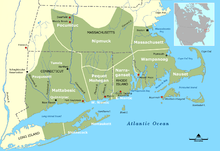
The earliest known inhabitants of New England were American Indians who spoke a variety of theEastern Algonquian languages.[5]Prominent tribes included theAbenakis,Mi'kmaq,Penobscot,Pequots,Mohegans,Narragansetts,Nipmucs,Pocumtucks,andWampanoags.[5]Prior to the arrival of European colonists, the Western Abenakis inhabited what is now New Hampshire, New York, and Vermont, as well as parts of Quebec and western Maine.[6]Their principal town wasNorridgewockin today's Maine.[7]
The Penobscots lived along thePenobscot Riverin Maine. The Narragansetts and smaller tribes under their sovereignty lived in Rhode Island, west of Narragansett Bay, includingBlock Island.The Wampanoags occupied southeastern Massachusetts, Rhode Island, and the islands ofMartha's VineyardandNantucket.The Pocumtucks lived in Western Massachusetts, and the Mohegan and Pequot tribes lived in Connecticut. TheConnecticut River Valleylinked numerous tribes culturally, linguistically, and politically.[5]
As early as the year 1600, French, Dutch, and English traders began exploring the New World, trading metal, glass, and cloth for local beaver pelts.[5][8]
Colonial period[edit]

On April 10, 1606, KingJames I of Englandissued a charter for theVirginia Company,which consisted of theLondon Companyand thePlymouth Company.These two privately funded ventures were intended to claim land for England, to conduct trade, and to return a profit. In 1620, thePilgrimsarrived on theMayflowerand establishedPlymouth Colonyin Massachusetts, beginning the history of permanent European colonization in New England.[9]
In 1616, English explorerJohn Smithnamed the region "New England".[10]The name was officially sanctioned on November 3, 1620,[11]when the charter of the Virginia Company of Plymouth was replaced by a royal charter for thePlymouth Council for New England,a joint-stock company established to colonize and govern the region.[12]The Pilgrims wrote and signed theMayflower Compactbefore leaving the ship,[13]and it became their first governing document.[14]TheMassachusetts Bay Colonycame to dominate the area and was established by royal charter in 1629[15][16]with its major town and port of Boston established in 1630.[17]
Massachusetts Puritans began to establish themselves in Connecticut as early as 1633.[18]Roger Williamswas banished from Massachusetts for theological reasons; he led a group south where they foundedProvidence Plantations,which grew into theColony of Rhode Island and Providence Plantationsin 1636.[19][20]At this time, Vermont was uncolonized, and the territories of New Hampshire and Maine were claimed and governed by Massachusetts. As the region grew, it received many immigrants from Europe due to its religious tolerance and economy.[21]
French and Indian Wars[edit]

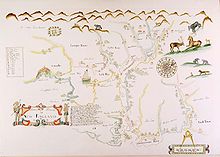
Relationships alternated between peace and armed skirmishes between colonists and localNative Americantribes, the bloodiest of which was thePequot Warin 1637 which resulted in theMystic massacre.[22]On May 19, 1643, the colonies of Massachusetts Bay, Plymouth,New Haven,and Connecticut joined in a loose compact called theNew England Confederation(officially "The United Colonies of New England" ). The confederation was designed largely to coordinate mutual defense, and it gained some importance duringKing Philip's War[23]which pitted the colonists and their Indian allies against a widespread Indian uprising from June 1675 through April 1678, resulting in killings and massacres on both sides.[24]In the aftermath of settler-Native conflicts, hundreds of captive Indians were sold intoslavery.[25][26]Up until 1700, Native Americans comprised a majority of the non-white labor force in colonial New England.[27]
During the next 74 years, there were six colonial wars that took place primarily between New England andNew France,[28]during which New England was allied with theIroquois Confederacyand New France was allied with theWabanaki Confederacy.Mainland Nova Scotia came under the control of New England after theSiege of Port Royal (1710),but both New Brunswick and most of Maine remained contested territory between New England and New France. The British eventually defeated the French in 1763, opening the Connecticut River Valley for British settlement into western New Hampshire and Vermont.
The New England Colonies were settled primarily by farmers who became relatively self-sufficient. Later, New England's economy began to focus on crafts and trade, aided by thePuritan work ethic,in contrast to the Southern colonies which focused on agricultural production while importing finished goods from England.[29]
Dominion of New England[edit]


By 1686,King James IIhad become concerned about the increasingly independent ways of the colonies, including their self-governing charters, their open flouting of theNavigation Acts,and their growing military power. He therefore established theDominion of New England,an administrative union including all of the New England colonies.[35]In 1688, the former Dutch colonies ofNew York,East New Jersey,andWest New Jerseywere added to the dominion. The union was imposed from the outside and contrary to the rooted democratic tradition of the colonies, and it was highly unpopular among the colonists.[36]
The dominion significantly modified the charters of the colonies, including the appointment of royal governors to nearly all of them. There was an uneasy tension among the royal governors, their officers, and the elected governing bodies of the colonies. The governors wanted unlimited authority, and the different layers of locally elected officials would often resist them. In most cases, the local town governments continued operating as self-governing bodies, just as they had before the appointment of the governors.[37]
After theGlorious Revolution,in 1689, Bostonians overthrew the royal governor,Sir Edmund Andros.During apopular and bloodless uprising,they seized dominion officials and adherents to theChurch of England.[38]These tensions eventually culminated in theAmerican Revolution,boiling over with the outbreak of theWar of American Independencein 1775. The first battles of which were fought inLe xing ton and Concord, Massachusetts,leading to theSiege of Bostonby continental troops. In March 1776, British forces were compelled to retreat from Boston.
New England in the new nation[edit]
After the dissolution of the Dominion of New England, the colonies of New England ceased to function as a unified political unit but remained a defined cultural region. There were often disputes over territorial jurisdiction, leading to land exchanges such as those regarding theEquivalent LandsandNew Hampshire Grants.[39]
By 1784, all of the states in the region had taken steps towards the abolition of slavery, with Vermont and Massachusetts introducing total abolition in 1777 and 1783, respectively.[40]The nickname "Yankeeland" was sometimes used to denote the New England area, especially among Southerners and the British.[41]
Vermont was admitted to statehood in 1791 after settling a dispute with New York. The territory of Maine had been a part of Massachusetts, but it was granted statehood on March 15, 1820, as part of theMissouri Compromise.[42]Today, New England is defined as the six states of Maine, Vermont, New Hampshire, Massachusetts, Rhode Island, and Connecticut.[43]
New England's economic growth relied heavily on trade with theBritish Empire,[44]and the region's merchants and politicians strongly opposed trade restrictions. As the United States and the United Kingdom fought theWar of 1812,New EnglandFederalistsorganized theHartford Conventionin the winter of 1814 to discuss the region's grievances concerning the war, and to propose changes to theUnited States Constitutionto protect the region's interests and maintain its political power.[45]Radical delegates within the convention proposed the region's secession from the United States, but they were outnumbered by moderates who opposed the idea.[46]
Politically, the region often disagreed with the rest of the country.[47]Massachusetts and Connecticut were among the last refuges of theFederalist Party,and New England became the strongest bastion of the newWhig Partywhen theSecond Party Systembegan in the 1830s. The Whigs were usually dominant throughout New England, except in the moreDemocraticMaine and New Hampshire.
Industrial Revolution[edit]


New England was key to theindustrial revolutionin the United States.[48]TheBlackstone Valleyrunning through Massachusetts and Rhode Island has been called the birthplace of America's industrial revolution.[49]In 1787, the first cotton mill in America was founded in theNorth Shoreseaport ofBeverly, Massachusettsas theBeverly Cotton Manufactory.[50]The Manufactory was also considered the largest cotton mill of its time. Technological developments and achievements from the Manufactory led to the development of more advanced cotton mills, includingSlater MillinPawtucket, Rhode Island.Towns such asLawrence, Massachusetts,Lowell, Massachusetts,Woonsocket, Rhode Island,andLewiston, Mainebecame centers of the textile industry following the innovations at Slater Mill and the Beverly Cotton Manufactory.[citation needed]
TheConnecticut River Valleybecame a crucible for industrial innovation, particularly theSpringfield Armory,pioneering such advances as interchangeable parts and the assembly line which influenced manufacturing processes all around the world.[51]From early in the nineteenth century until the mid-twentieth, the region surroundingSpringfield, MassachusettsandHartford, Connecticutserved as the United States' epicenter for advanced manufacturing, drawing skilled workers from all over the world.[52][53]
The rapid growth of textile manufacturing in New England between 1815 and 1860 caused a shortage of workers. Recruiters were hired by mill agents to bring young women and children from the countryside to work in the factories. Between 1830 and 1860, thousands of farm girls moved from rural areas where there was no paid employment to work in the nearby mills, such as theLowell Mill Girls.As the textile industry grew, immigration also grew. By the 1850s, immigrants began working in the mills, especiallyFrench CanadiansandIrish.[54]
New England as a whole was the most industrialized part of the United States. By 1850, the region accounted for well over a quarter of all manufacturing value in the country and over a third of its industrial workforce.[55]It was also the most literate and most educated region in the country.[55]
During the same period, New England and areas settled by New Englanders (upstate New York, Ohio'sWestern Reserve,and the upper midwestern states ofMichiganandWisconsin) were the center of the strongest abolitionist and anti-slavery movements in the United States, coinciding with the ProtestantGreat Awakeningin the region.[56]Abolitionists who demanded immediate emancipation had their base in the region, such asWilliam Lloyd Garrison,John Greenleaf Whittier,andWendell Phillips.So too did anti-slavery politicians who wanted to limit the growth of slavery, such asJohn Quincy Adams,Charles Sumner,andJohn P. Hale.The anti-slaveryRepublican Partywas formed in the 1850s, and all of New England became strongly Republican, including areas that had previously been strongholds for both the Whig and the Democratic parties. New England remained solidly Republican until Catholics began to mobilize behind the Democrats, especially in 1928. This led to the end of "Yankee Republicanism" and began New England's relatively swift transition into aconsistently Democratic strongholdin national elections.[57]
20th century and beyond[edit]

The flow of immigrants continued at a steady pace from the 1840s until cut off byWorld War I.The largest numbers came from Ireland and Britain before 1890, and after that from Quebec, Italy, and Southern Europe. The immigrants filled the ranks of factory workers, craftsmen, and unskilled laborers. The Irish assumed a larger and larger role in the Democratic Party in the cities and statewide, while the rural areas remained Republican.
TheGreat Depression in the United Statesof the 1930s hit the region hard, with high unemployment in the industrial cities. TheBoston Stock Exchangerivaled theNew York Stock Exchangein 1930. In the beginning of 1930John C. Hull,first Securities Director of Massachusetts (1930–1936), helped to mitigate the consequences of theWall Street Crash of 1929and the Great Depression. He was helpful in the passing of theSecurities Exchange Act of 1934with his war on "unlisted securities".[58]Hull gave testimony to the US Senate (Sen.Duncan Upshaw Fletcher) for work on thePecora Commission,which revealed that neitherAlbert H. Wiggin(born in Medfield, MA) norJ. P. Morgan Jr.had paid any income taxes in 1931 and 1932; a public outcry ensued.[59]
Bostonfigured prominently on the subject of securities laws in the early 1930s in response to the Great Depression.Harvard UniversityprofessorsFelix Frankfurter,Benjamin V. Cohen,andJames M. Landisdrafted the Securities Act of 1933 and the Securities Exchange Act of 1934.Joseph P. Kennedy Sr.was the first chairman of theU.S. Securities and Exchange Commission,and he was from Boston.[60]
The Democrats appealed to factory workers and especially Catholics, pulling them into theNew Deal coalitionand making the once-Republican region into one that was closely divided. However, the enormous spending on munitions, ships, electronics, and uniforms duringWorld War IIcaused a burst of prosperity in every sector.
The region lost most of its factories starting with the loss of textiles in the 1930s and getting worse after 1960. The New England economy was radically transformed after World War II. The factory economy practically disappeared. Once-bustling New England communities fell into economic decay following the flight of the region's industrial base. The textile mills one by one went out of business from the 1920s to the 1970s. For example, the Crompton Company went bankrupt in 1984 after 178 years in business, costing the jobs of 2,450 workers in five states. The major reasons were cheap imports, the strong dollar, declining exports, and a failure to diversify.[61]The shoe industry subsequently left the region as well.

What remains is very high technology manufacturing, such as jet engines, nuclear submarines, pharmaceuticals, robotics, scientific instruments, and medical devices. The Massachusetts Institute of Technology invented the format for university-industry relations in high tech fields and spawned many software and hardware firms, some of which grew rapidly.[62]By the 21st century, the region had become famous for its leadership roles in the fields of education, medicine, medical research, high-technology, finance, and tourism.[63]
Some industrial areas were slow in adjusting to the new service economy. In 2000, New England had two of the ten poorest cities in the U.S. (by percentage living below the poverty line): the state capitals ofProvidence, Rhode IslandandHartford, Connecticut.[64]They were no longer in the bottom ten by 2010; Connecticut, Massachusetts, and New Hampshire remain among the ten wealthiest states in the United States in terms of median household income and per capita income.[65]
Geography[edit]
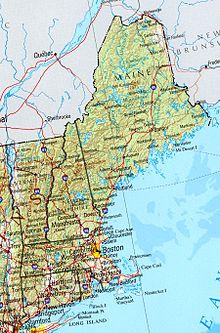
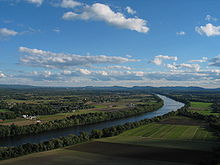
The states of New England have a combined area, including water surfaces, of 71,988 square miles (186,447 km2),[66]making the region slightly larger than thestate of Washingtonand slightly smaller thanGreat Britain.[67][68]Maine alone constitutes nearly one-half of the total area of New England, yet is only the 39th-largest state, slightly smaller thanIndiana.The remaining states are among the smallest in the U.S., including thesmallest state—Rhode Island.
The areas of the states (including water area) are:
- Maine,35,380 square miles (91,600 km2)
- Massachusetts,10,554 square miles (27,330 km2)
- Vermont,9,616 square miles (24,910 km2)
- New Hampshire,9,349 square miles (24,210 km2)
- Connecticut,5,543 square miles (14,360 km2)
- Rhode Island,1,545 square miles (4,000 km2)[69]
Geology[edit]
New England's long rolling hills, mountains, and jagged coastline areglacial landformsresulting from the retreat of ice sheets approximately 18,000 years ago, during thelast glacial period.[70][71]
New England is geologically a part of theNew England province,anexotic terraneregion consisting of theAppalachian Mountains,the New England highlands and the seaboard lowlands.[72]The Appalachian Mountains roughly follow the border between New England and New York.The Berkshiresin Massachusetts and Connecticut, and theGreen Mountainsin Vermont, as well as theTaconic Mountains,form a spine ofPrecambrianrock.[73]
The Appalachians extend northwards into New Hampshire as theWhite Mountains,and then into Maine and Canada.Mount Washingtonin New Hampshire is the highest peak in the Northeast, although it is not among the ten highest peaks in the eastern United States.[74]It is the site of the secondhighest recorded wind speedon Earth,[75][76]and has the reputation of having the world's most severe weather.[77][78]
The coast of the region, extending from southwestern Connecticut to northeastern Maine, is dotted with lakes, hills, marshes and wetlands, and sandy beaches.[71]Important valleys in the region include theChamplain Valley,theConnecticut River Valleyand theMerrimack Valley.[71]The longest river is theConnecticut River,which flows from northeastern New Hampshire for 407 mi (655 km), emptying intoLong Island Sound,roughly bisecting the region.Lake Champlain,which forms part of the border between Vermont and New York, is the largest lake in the region, followed byMoosehead Lakein Maine andLake Winnipesaukeein New Hampshire.[71]
Climate[edit]
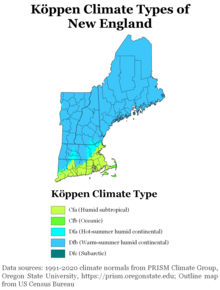

The climate of New England varies greatly across its 500 miles (800 km) span from northern Maine to southern Connecticut:
Maine, New Hampshire, Vermont, and western Massachusetts have ahumid continentalclimate (Dfb inKöppen climate classification). In this region the winters are long and cold, and heavy snow is common (most locations receive 60–120 inches (150–300 cm) of snow annually in this region). The summer's months are moderately warm, though summer is rather short and rainfall is spread through the year.
In central and eastern Massachusetts, northern Rhode Island, and northern Connecticut, the same humid continental prevails (Dfa), though summers are warm to hot, winters are shorter, and there is less snowfall (especially in the coastal areas where it is often warmer).
Southern and coastal Connecticut is the broad transition zone from the coldcontinental climatesof the north to the mildersubtropicalclimates to the south. The frost free season is greater than 180 days across far southern/coastal Connecticut, coastal Rhode Island, and the islands (Nantucket and Martha's Vineyard). Winters also tend to be much sunnier in southern Connecticut and southern Rhode Island compared to the rest of New England.[79]
Regions[edit]
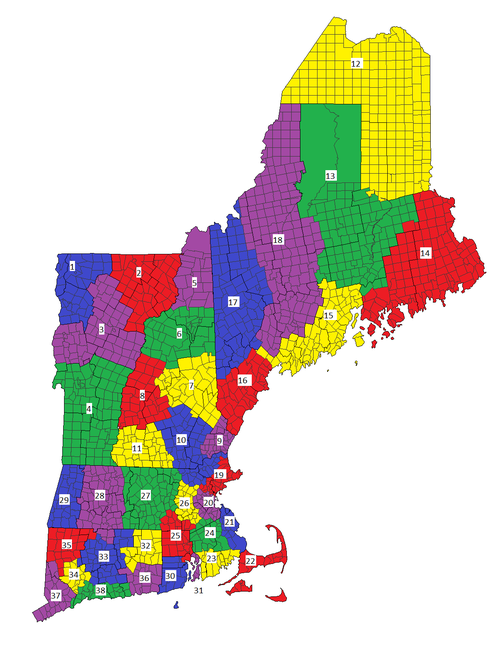
2.Northeast Kingdom
3. Central Vermont
4. Southern Vermont
5.Great North Woods Region
6.White Mountains
7.Lakes Region
8.Dartmouth/Lake Sunapee Region
9.Seacoast Region
10.Merrimack Valley
11.Monadnock Region
12.Aroostook
13.Maine Highlands
14.Acadia/Down East
15.Mid-Coast/Penobscot Bay
16.Southern Maine/South Coast
17.Mountain and Lakes Region
18.Kennebec Valley
19.North Shore
20.Metro Boston
21.South Shore
22.Cape Cod and Islands
23.South Coast
24.Southeastern Massachusetts
25.Blackstone River Valley
26.Metrowest/Greater Boston
27.Central Massachusetts
28.Pioneer Valley
29.The Berkshires
30.South County
31.East Bay
32.Quiet Corner
33.Greater Hartford
34.Central Naugatuck Valley
35.Northwest Hills
36.Southeastern Connecticut/Greater New London
37.Western Connecticut
38.Connecticut Shoreline
Biodiversity[edit]
New England containsforestedecosystems with a variety of terrestrial vertebrates. Land-use patterns and land disturbance, such as the dramatic increase in land clearing for agriculture in the mid eighteenth century to nineteenth century, greatly altered the ecosystem and resulted in extinctions,local extirpations,and recolonizations.[80]
According to an analysis of USDA Forest Service data, tree species diversity increases from north to south at about 2-3 species per degree in latitude. In addition, taller trees are associated with higher tree species diversity, and tree height is a better predictor than general forest age or biomass. Due to an increasing the amount of nitrogen in the soil from climate change, thered mapleis becoming one of the most abundant trees in the region, and outcompeting other maples such as thesugar maple.[81]
Largest cities[edit]
The most populous cities as of the 2020 U.S. Census were (metropolitan areas in parentheses):[82][83]
 Boston, Massachusetts:675,647 (4,941,632)
Boston, Massachusetts:675,647 (4,941,632) Worcester, Massachusetts:206,518 (923,672)
Worcester, Massachusetts:206,518 (923,672) Providence, Rhode Island:190,934 (1,604,291)
Providence, Rhode Island:190,934 (1,604,291) Springfield, Massachusetts:155,929 (699,162)
Springfield, Massachusetts:155,929 (699,162) Bridgeport, Connecticut:148,654 (939,904)
Bridgeport, Connecticut:148,654 (939,904) Stamford, Connecticut:135,470 (part ofGreater Bridgeport)
Stamford, Connecticut:135,470 (part ofGreater Bridgeport) New Haven, Connecticut:134,023 (862,477)
New Haven, Connecticut:134,023 (862,477) Hartford, Connecticut:121,054 (1,214,295)
Hartford, Connecticut:121,054 (1,214,295) Cambridge, Massachusetts:118,403 (part ofGreater Boston)
Cambridge, Massachusetts:118,403 (part ofGreater Boston) Manchester, New Hampshire:115,644 (406,678)
Manchester, New Hampshire:115,644 (406,678)
During the 20th century, urban expansion in regions surroundingNew York Cityhas become an important economic influence on neighboring Connecticut, parts of which belong to theNew York metropolitan area.The U.S. Census Bureau groupsFairfield,New HavenandLitchfieldcounties in western Connecticut together with New York City and other parts of New York andNew Jerseyas acombined statistical area.[84]
- Major cities of New England
Metropolitan areas and capitals[edit]
Metropolitan areas[edit]
The following aremetropolitan statistical areasas defined by theUnited States Census Bureau.
| Rank | Metropolitan area | State(s) | Population (2020) | EncompassingCSA |
|---|---|---|---|---|
| 1 | Boston | 4,941,632 | Boston | |
| 2 | Providence | 1,676,579 | Boston | |
| 3 | Hartford | 1,213,531 | Hartford | |
| 4 | Worcester | 978,529 | Boston | |
| 5 | Bridgeport | 957,419 | New York | |
| 6 | New Haven | 864,835 | Hartford | |
| 7 | Springfield | 699,162 | Springfield | |
| 8 | Portland | 551,740 | Portland | |
| 9 | Manchester-Nashua | 422,937 | Boston | |
| 10 | Norwich-New London | 268,555 | Hartford | |
| 11 | Barnstable | 228,996 | Boston | |
| 12 | Burlington | 225,562 | Burlington | |
| 13 | Bangor | 152,199 | — | |
| 14 | Pittsfield | 129,026 | — | |
| 15 | Lewiston-Auburn | 111,139 | Portland |
State capitals[edit]
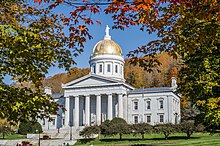
- Hartford, Connecticut
- Augusta, Maine
- Boston, Massachusetts
- Concord, New Hampshire
- Providence, Rhode Island
- Montpelier, Vermont
Demographics[edit]
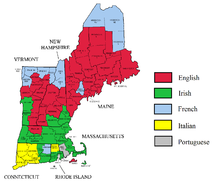
In 2020, New England had a population of 15,116,205, a growth of 4.6% from 2010.[86]Massachusetts is the most populous state with 7,029,917 residents, while Vermont is the least populous state with 643,077 residents.[86]Boston is by far the region's most populous city and metropolitan area.
Although a great disparity exists between New England's northern and southern portions, the region's average population density is 234.93 inhabitants/sq mi (90.7/km2). New England has a significantly higher population density than that of the U.S. as a whole (79.56/sq mi), or even just the contiguous 48 states (94.48/sq mi). Three-quarters of the population of New England, and most of the major cities, are in southern New England—the states of Connecticut, Massachusetts and Rhode Island—where the combined population density is 786.83/sq mi (2000 census). In northern New England—the states of Maine, New Hampshire, and Vermont—the combined population density is 63.56/sq mi (2000 census).
According to the 2006–08American Community Survey,48.7% of New Englanders were male and 51.3% were female. Approximately 22.4% of the population were under 18 years of age; 13.5% were over 65 years of age. The six states of New England have the lowest birth rate in the U.S.[87]


White Americansmake up the majority of New England's population at 73.4% of the total population,Hispanic and Latino Americansare New England's largest minority, and they are the second-largest group in the region behind non-HispanicEuropean Americans.As of 2014, Hispanics and Latinos of any race made up 10.2% of New England's population. Connecticut had the highest proportion at 13.9%, while Vermont had the lowest at 1.3%. There were nearly 1.5 million Hispanic and Latino individuals reported in New England in 2014.
Puerto Ricanswere the most numerous of the Hispanic and Latino subgroups. Over 660,000 Puerto Ricans lived in New England in 2014, forming 4.5% of the population. TheDominicanpopulation is over 200,000, and theMexicanandGuatemalanpopulations are each over 100,000.[88]Americans of Cuban descentare scant in number; there were roughly 26,000 Cuban Americans in the region in 2014. People of all other Hispanic and Latino ancestries, includingSalvadoran,ColombianandBolivian,formed 2.5% of New England's population and numbered over 361,000 combined.[88]
According to the 2014 American Community Survey, the top ten largest reported European ancestries were the following:[89]Irish:19.2% (2.8 million),English(includes "American"ancestry): 16.7% (2.4 million),Italian:13.6% (2.0 million),FrenchandFrench Canadian:13.1% (1.9 million),[90]German:7.4% (1.1 million),Polish:4.9% (roughly 715,000),Portuguese:3.2% (467,000),Scottish:2.5% (370,000),Russian:1.4% (206,000), andGreek:1.0% (152,000).
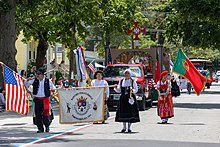
English is, by far, the most common language spoken at home. Approximately 81.3% of all residents (11.3 million people) over the age of five spoke only English at home. Roughly 1,085,000 people (7.8% of the population) spoke Spanish at home, and roughly 970,000 people (7.0% of the population) spoke otherIndo-European languagesat home. Over 403,000 people (2.9% of the population) spoke anAsianor Pacific Island language at home.[92]Slightly fewer (about 1%) spoke French at home,[93]although this figure is above 20% in northern New England, which borders francophone Québec.[citation needed]Roughly 99,000 people (0.7% of the population) spoke languages other than these at home.[92]
As of 2014, approximately 87% of New England's inhabitants were born in the U.S., while over 12% were foreign-born.[94]35.8% of foreign-born residents were born in Latin America, 28.6% were born in Asia,[95]22.9% were born in Europe, and 8.5% were born in Africa.[96]
Southern New England forms an integral part of theBosWashmegalopolis,a conglomeration of urban centers that spans from Boston to Washington, D.C. The region includes three of the fourmost densely populated states in the U.S.;only New Jersey has a higher population density than the states of Rhode Island, Massachusetts, and Connecticut.
Greater Boston,which includes parts of southern New Hampshire, has a total population of approximately 4.8 million,[82]while over half the population of New England falls inside Boston'sCombined Statistical Areaof over 8.2 million.[97]
Economy[edit]

Several factors combine to make the New England economy unique. The region is distant from the geographic center of the country, and it is a relatively small region but densely populated. It historically has been an important center of industry and manufacturing and a supplier of natural resource products, such as granite, lobster, andcodfish.The service industry is important, including tourism, education, financial and insurance services, and architectural, building and construction services. TheU.S. Department of Commercehas called the New England economy a microcosm for the entire U.S. economy.[98]
The region underwent a long period of deindustrialization in the first half of the 20th century, as traditional manufacturing companies relocated to the Midwest, with textile and furniture manufacturing migrating to the South. In the late-20th century, an increasing portion of the regional economy included high technology, military defense industry, finance and insurance services, and education and health services. As of 2018, the GDP of New England was $1.1 trillion.[99]
New England exports food products ranging from fish to lobster, cranberries, potatoes, and maple syrup. About half of the region's exports consist of industrial and commercial machinery, such as computers and electronic and electrical equipment. Granite is quarried atBarre, Vermont,[100]guns made atSpringfield, Massachusetts,andSaco, Maine,submarines atGroton, Connecticut,surface naval vessels atBath, Maine,and hand tools atTurners Falls, Massachusetts.
Urban centers[edit]
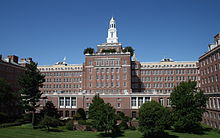
In 2017, Boston was ranked as having the ninth-most competitive financial center in the world and the fourth-most competitive in the United States.[101]Boston-basedFidelity Investmentshelped popularize the mutual fund in the 1980s and has made Boston one of the top financial centers in the United States.[102]The city is home to the headquarters ofSantander Bankand a center for venture capital firms.State Street Corporationspecializes in asset management and custody services and is based in the city.
Boston is also a printing and publishing center.[103]Houghton Mifflin Harcourtis headquartered there, along withBedford-St. Martin'sandBeacon Press.The city is also home to theHynes Convention Centerin the Back Bay and theSeaport Hotel and Seaport World Trade CenterandBoston Convention and Exhibition Centeron the South Boston waterfront.[104]
TheGeneral Electric Corporationannounced its decision to move the company's global headquarters to the Boston Seaport District fromFairfield, Connecticut,in 2016, citing factors including Boston's preeminence in the realm of higher education.[105]The city also holds the headquarters to several major athletic and footwear companies, includingConverse,New BalanceandReebok.Rockport,PumaandWolverine World Widehave headquarters or regional offices[106]just outside the city.[107]
Hartford is the historic international center of the insurance industry, with companies such asAetna,Conning & Company,The Hartford,Harvard Pilgrim Health Care,The Phoenix CompaniesandHartford Steam Boilerbased in the city, andThe Travelers CompaniesandLincoln National Corporationhave major operations in the city. It is also home to the corporate headquarters ofU.S. Fire Arms Mfg. Co.,United Technologies,andVirtus Investment Partners.[108]
Fairfield County, Connecticut,has a large concentration of investment management firms in the area, most notablyBridgewater Associates(one of the world's largest hedge fund companies), Aladdin Capital Management andPoint72 Asset Management.Moreover, many international banks have their North American headquarters in Fairfield County, such asNatWest GroupandUBS.
Agriculture[edit]
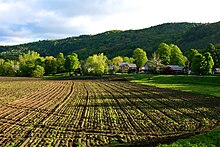
Agriculture is limited by the area's rocky soil, cool climate, and small area. Some New England states, however, are ranked highly among U.S. states for particular areas of production. Maine is ranked ninth foraquaculture,[109]and has abundant potato fields in its northeast part. Vermont is fifteenth for dairy products,[110]and Connecticut and Massachusetts seventh and eleventh for tobacco, respectively.[111][112]Cranberries are grown in Massachusetts'Cape Cod-Plymouth-South Shore area, and blueberries in Maine.
Energy[edit]

The region is mostly energy-efficient compared to the U.S. at large, with every state but Maine ranking within the ten most energy-efficient states;[113]every state in New England also ranks within the ten most expensive states for electricity prices.[114]Wind power, mainly from offshore sources, is expected to gain market share in the 2020s.
Employment[edit]
| Employment area | October 2010 | October 2011 | October 2012 | October 2013 | December 2014 | December 2015[115] | December 2016[116] | Net change |
|---|---|---|---|---|---|---|---|---|
| United States | 9.7 | 9.0 | 7.9 | 7.2 | 5.6 | 5.0 | 4.7 | −5.0 |
| New England | 8.3 | 7.6 | 7.4 | 7.1 | 5.4 | 4.3 | 3.5 | −4.7 |
| Connecticut | 9.1 | 8.7 | 9.0 | 7.6 | 6.4 | 5.2 | 4.4 | −4.7 |
| Maine | 7.6 | 7.3 | 7.4 | 6.5 | 5.5 | 4.0 | 3.8 | −3.8 |
| Massachusetts | 8.3 | 7.3 | 6.6 | 7.2 | 5.5 | 4.7 | 2.8 | −5.5 |
| New Hampshire | 5.7 | 5.3 | 5.7 | 5.2 | 4.0 | 3.1 | 2.6 | −3.1 |
| Rhode Island | 11.5 | 10.4 | 10.4 | 9.4 | 6.8 | 5.1 | 5.0 | −6.5 |
| Vermont | 5.9 | 5.6 | 5.5 | 4.4 | 4.2 | 3.6 | 3.1 | −2.8 |
As of January 2017, employment is stronger in New England than in the rest of the United States. During theGreat Recession,unemployment rates ballooned across New England as elsewhere; however, in the years that followed, these rates declined steadily, with New Hampshire and Massachusetts having the lowest unemployment rates in the country, respectively. The most extreme swing was in Rhode Island, which had an unemployment rate above 10% following the recession, but which saw this rate decline by over 6% in six years.
As of December 2016, themetropolitan statistical area(MSA) with the lowest unemployment rate, 2.1%, wasBurlington-South Burlington, Vermont;the MSA with the highest rate, 4.9%, wasWaterbury, Connecticut.[117]
Overall tax burden[edit]
In 2023, three of the six New England states were among the top ten states in the country in terms of taxes paid per taxpayer, while one was among the top five least. The rankings being #3 Maine (11.14%), #4 Vermont (10.28%), #5 Connecticut (9.83%), #11 Rhode Island (9.07%), #20 Massachusetts (8.48%), and #48 New Hampshire (6.14%). While overall tax burden varies widely, all six states sport exceptionally high property taxes with five of the six states being within the nationwide top 10. The rankings being #1 Maine (5.33%), #2 Vermont (4.98%), #3 New Hampshire (4.94%), #6 Connecticut (4.24%), #7 Rhode Island (4.17%), and #13 Massachusetts (3.42%).[118]
Government[edit]
Town meetings[edit]
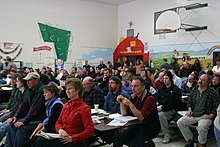
New England town meetingswere derived from meetings held by church elders, and are still an integral part of government in manyNew England towns.At such meetings, any citizen of the town may discuss issues with other members of the community and vote on them. This is the strongest example ofdirect democracyin the U.S. today, and the strong democratic tradition was even apparent in the early 19th century, whenAlexis de Tocquevillewrote inDemocracy in America:
New England, where education and liberty are the daughters of morality and religion, where society has acquired age and stability enough to enable it to form principles and hold fixed habits, the common people are accustomed to respect intellectual and moral superiority and to submit to it without complaint, although they set at naught all those privileges which wealth and birth have introduced among mankind. In New England, consequently, the democracy makes a more judicious choice than it does elsewhere.[119]
By contrast,James Madisonwrote inFederalist No. 55that, regardless of the assembly, "passion never fails to wrest the scepter from reason. Had every Athenian citizen been a Socrates, every Athenian assembly would still have been a mob."[120]The use and effectiveness of town meetings is still discussed by scholars, as well as the possible application of the format to other regions and countries.[121]
Politics[edit]
Elections[edit]
State and national elected officials in New England recently have been elected mainly from the Democratic Party.[122]The region is generally considered to be the most liberal in the United States, with more New Englanders identifying as liberals than Americans elsewhere. In 2010, four of six of the New England states were polled as the most liberal in the United States.[123]

As of 2021, five of the six states of New England have voted for every Democratic presidential nominee since 1992. In that time, New Hampshire has voted for Democratic nominees in every presidential election except 2000, whenGeorge W. Bushnarrowly won the state. 2020 was a particularly strong year for Democratic nomineeJoe Bidenin New England, winning 61.2% of the total vote in the six states, the highest percentage for Democrats since the landslide election of 1964.[124]As of the117th Congress,all members of theU.S. House of Representativesfrom New England are members of the Democratic Party, and all but one of itssenatorscaucus with the Democrats. Two of those senators, although caucusing with Democrats, are two of the only threeindependentscurrently serving in the Senate:Bernie Sanders,a self-describeddemocratic socialist,[125][126]representing Vermont andAngus King,an Independent representing Maine.
In the2008 presidential election,Barack Obama carried all six New England states by 9 percentage points or more.[127]He carried every county in New England except forPiscataquis County,Maine,which he lost by 4% to SenatorJohn McCain(R-AZ). Pursuant to the reapportionment following the 2010 census, New England collectively has 33electoral votes.
The following table presents the vote percentage for the popular-vote winner for each New England state, New England as a whole, and the United States as a whole, in each presidential election from 1900 to 2020, with the vote percentage for the Republican candidate shaded in red and the vote percentage for the Democratic candidate shaded in blue:
| Year | Connecticut | Maine | Massachusetts | New Hampshire | Rhode Island | Vermont | New England | United States |
|---|---|---|---|---|---|---|---|---|
| 2020 | 59.2% | 53.1% | 65.6% | 52.7% | 59.4% | 66.1% | 61.2% | 51.3% |
| 2016 | 54.6% | 47.8% | 60.0% | 46.8% | 54.4% | 56.7% | 55.3% | 48.2% |
| 2012 | 58.1% | 56.3% | 60.7% | 52.0% | 62.7% | 66.6% | 59.1% | 51.1% |
| 2008 | 60.6% | 57.7% | 61.8% | 54.1% | 62.9% | 67.5% | 60.6% | 52.9% |
| 2004 | 54.3% | 53.6% | 61.9% | 50.2% | 59.4% | 58.9% | 57.7% | 50.7% |
| 2000 | 55.9% | 49.1% | 59.8% | 48.1% | 61.0% | 50.6% | 56.1% | 48.4% |
| 1996 | 52.8% | 51.6% | 61.5% | 49.3% | 59.7% | 53.4% | 56.8% | 49.2% |
| 1992 | 42.2% | 38.8% | 47.5% | 38.9% | 47.0% | 46.1% | 44.4% | 43.0% |
| 1988 | 52.0% | 55.3% | 53.2% | 62.5% | 55.6% | 51.1% | 49.5% | 53.4% |
| 1984 | 60.7% | 60.8% | 51.2% | 68.7% | 51.7% | 57.9% | 56.2% | 58.8% |
| 1980 | 48.2% | 45.6% | 41.9% | 57.7% | 47.7% | 44.4% | 44.7% | 50.8% |
| 1976 | 52.1% | 48.9% | 56.1% | 54.7% | 55.4% | 54.3% | 51.7% | 50.1% |
| 1972 | 58.6% | 61.5% | 54.2% | 64.0% | 53.0% | 62.7% | 52.5% | 60.7% |
| 1968 | 49.5% | 55.3% | 63.0% | 52.1% | 64.0% | 52.8% | 56.1% | 43.4% |
| 1964 | 67.8% | 68.8% | 76.2% | 63.9% | 80.9% | 66.3% | 72.8% | 61.1% |
| 1960 | 53.7% | 57.0% | 60.2% | 53.4% | 63.6% | 58.6% | 56.0% | 49.7% |
| 1956 | 63.7% | 70.9% | 59.3% | 66.1% | 58.3% | 72.2% | 62.0% | 57.4% |
| 1952 | 55.7% | 66.0% | 54.2% | 60.9% | 50.9% | 71.5% | 56.1% | 55.2% |
| 1948 | 49.5% | 56.7% | 54.7% | 52.4% | 57.6% | 61.5% | 51.5% | 49.6% |
| 1944 | 52.3% | 52.4% | 52.8% | 52.1% | 58.6% | 57.1% | 52.4% | 53.4% |
| 1940 | 53.4% | 51.1% | 53.1% | 53.2% | 56.7% | 54.8% | 52.8% | 54.7% |
| 1936 | 55.3% | 55.5% | 51.2% | 49.7% | 53.1% | 56.4% | 50.9% | 60.8% |
| 1932 | 48.5% | 55.8% | 50.6% | 50.4% | 55.1% | 57.7% | 49.1% | 57.4% |
| 1928 | 53.6% | 68.6% | 50.2% | 58.7% | 50.2% | 66.9% | 53.2% | 58.2% |
| 1924 | 61.5% | 72.0% | 62.3% | 59.8% | 59.6% | 78.2% | 63.3% | 54.0% |
| 1920 | 62.7% | 68.9% | 68.5% | 59.8% | 64.0% | 75.8% | 66.7% | 60.3% |
| 1916 | 49.8% | 51.0% | 50.5% | 49.1% | 51.1% | 62.4% | 51.1% | 49.2% |
| 1912 | 39.2% | 39.4% | 35.5% | 39.5% | 39.0% | 37.1% | 36.6% | 41.8% |
| 1908 | 59.4% | 63.0% | 58.2% | 59.3% | 60.8% | 75.1% | 60.2% | 51.6% |
| 1904 | 58.1% | 67.4% | 57.9% | 60.1% | 60.6% | 78.0% | 60.4% | 56.4% |
| 1900 | 56.9% | 61.9% | 57.6% | 59.3% | 59.7% | 75.7% | 59.4% | 51.6% |
Political party strength[edit]
Judging purely by party registration rather than voting patterns, New England today is one of the most Democratic regions in the U.S.[128][129][130]According toGallup,Connecticut,Massachusetts,Rhode Island,andVermontare "solidly Democratic",Maine"leans Democratic", andNew Hampshireis a swing state.[131]Though New England is today considered a Democratic Party stronghold, much of the region was staunchly Republican before the mid-twentieth century. This changed in the late 20th century, in large part due to demographic shifts[132]and the Republican Party's adoption of socially conservative platforms as part of their strategicshift towards the South.[57]For example, Vermont voted Republican in every presidential election from 1856 through 1988 with the exception of 1964, and has voted Democratic every election since. Maine and Vermont were the only two states in the nation to vote against DemocratFranklin D. Rooseveltall four times he ran for president. Republicans in New England are today considered by both liberals and conservatives to bemore moderate(socially liberal) compared to Republicans in other parts of the U.S.[133]
| State | Governor | Senior U.S. Senator | Junior U.S. Senator | U.S. House Delegation | Upper House Majority | Lower House Majority |
|---|---|---|---|---|---|---|
| CT | N. Lamont | R. Blumenthal | C. Murphy | Democratic 5–0 | Democratic 24–12 | Democratic 97–54 |
| ME | J. Mills | S. Collins | A. King[†] | Democratic 2-0 | Democratic 22–13 | Democratic 82–67–2 |
| MA | M. Healey | E. Warren | E. Markey | Democratic 9–0 | Democratic 37–3 | Democratic 132–25–1 |
| NH | C. Sununu | J. Shaheen | M. Hassan | Democratic 2-0 | Republican 14–10 | Republican 198-196-3 |
| RI | D. McKee | J. Reed | S. Whitehouse | Democratic 2–0 | Democratic 33–5 | Democratic 65-9-1 |
| VT | P. Scott | B. Sanders[†] | P. Welch | Democratic 1–0 | Democratic 22–7–1 | Democratic 104–38–5–3 |
| :†Elected as an independent, but caucuses with the Democratic Party. | ||||||
New Hampshire primary[edit]

Historically, theNew Hampshire primaryhas been the first in a series of nationwide political partyprimary electionsheld in the United States every four years. Held in the state ofNew Hampshire,it usually marks the beginning of theU.S. presidential electionprocess. Even though few delegates are chosen from New Hampshire, the primary has always been pivotal to both New England and American politics. One college in particular,Saint Anselm College,has been home to numerous national presidential debates and visits by candidates to its campus.[134]
Education[edit]
Colleges and universities[edit]
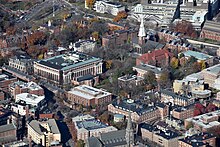
New England contains some of the oldest and most renowned institutions of higher learning in the United States and the world.Harvard Collegewas the first such institution, founded in 1636 atCambridge, Massachusetts,to train preachers.Yale Universitywas founded inSaybrook,Connecticut,in 1701, and awarded the nation's first doctoral (PhD) degree in 1861. Yale moved toNew Haven, Connecticut,in 1718, where it has remained to the present day.
Brown Universitywas the first college in the nation to accept students of all religious affiliations, and is the seventh oldest U.S. institution of higher learning. It was founded inProvidence, Rhode Island,in 1764.Dartmouth Collegewas founded five years later inHanover, New Hampshire,with the mission of educating the localAmerican Indianpopulation as well as English youth. TheUniversity of Vermont,the fifth oldest university in New England, was founded in 1791, the same year that Vermont joined theUnion.
In addition to four out of eightIvy Leagueschools, New England contains theMassachusetts Institute of Technology(MIT), the bulk of educational institutions that are identified as the "Little Ivies",four of the originalSeven Sisters,one of the eight originalPublic Ivies,theColleges of Worcester Consortiumin central Massachusetts, and theFive Collegesconsortium in western Massachusetts. TheUniversity of Maine,theUniversity of New Hampshire,theUniversity of Connecticut,theUniversity of Massachusetts at Amherst,theUniversity of Rhode Island,and theUniversity of Vermontare the flagship state universities in the region.
Private and independent secondary schools[edit]
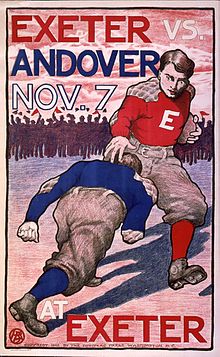
At the pre-college level, New England is home to a number of American independent schools (also known as private schools). The concept of the elite "New Englandprep school"(preparatory school) and the"preppy"lifestyle is an iconic part of the region's image.[135]
- See the list of private schools for each state:
Connecticut,Massachusetts,Maine,New Hampshire,Rhode Island,Vermont.
Public education[edit]
New England is home to some of the oldest public schools in the nation and was the first region in the United States to implement universalcompulsory schooling.Boston Latin Schoolis the oldest public school in America and was attended by several signatories of the Declaration of Independence.[136]Hartford Public High Schoolis the second oldest operating high school in the U.S.[137]
As of 2005, theNational Education Associationranked Connecticut as having the highest-paid teachers in the country. Massachusetts and Rhode Island ranked eighth and ninth, respectively.
New Hampshire, Rhode Island, and Vermont have cooperated in developing aNew England Common Assessment Programtest under theNo Child Left Behindguidelines. These states can compare the resultant scores with each other.
Academic journals and press[edit]
There are several academic journals and publishing companies in the region, includingThe New England Journal of Medicine,Harvard University PressandYale University Press.Some of its institutions lead theopen accessalternative to conventional academic publication, includingMIT,theUniversity of Connecticut,and theUniversity of Maine.TheFederal Reserve Bank of Bostonpublishes theNew England Economic Review.[138]
Culture[edit]

New England has a shared heritage and culture primarily shaped by waves of immigration from Europe.[140]In contrast to other American regions, many of New England's earliest Puritan settlers came from eastern England, contributing to New England's distinctive accents, foods, customs, and social structures.[141]: 30–50 Within modern New England a cultural divide exists between urban New Englanders living along the densely populated coastline, and rural New Englanders in western Massachusetts, northwestern and northeastern Connecticut, Vermont, New Hampshire, and Maine, where population density is low.[142]There is also a substantial divide between Connecticut and the other states of the region, owing to the former's close cultural and economic ties with the New York metropolitan area.[143][144]
Religion[edit]
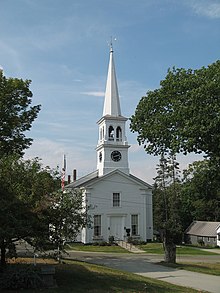
Today, New England is the least religious region of the U.S. In 2009, less than half of those polled in Maine, Massachusetts, New Hampshire, and Vermont claimed that religion was an important part of their daily lives. Connecticut and Rhode Island are among the ten least religious states, where 55% and 53% of those polled (respectively) claimed that it was important.[145]According to theAmerican Religious Identification Survey,34% of Vermonters claimed to have no religion; nearly one out of every four New Englanders identifies as having no religion, more than in any other part of the U.S.[146]New England had one of the highest percentages of Catholics in the U.S. This number declined from 50% in 1990 to 36% in 2008.[146]
Cultural roots[edit]
Many of the first European colonists of New England had amaritimeorientation towardwhaling(first noted about 1650)[147]and fishing, in addition to farming. New England has developed a distinctcuisine,dialect,architecture,and government. New England cuisine has a reputation for its emphasis on seafood and dairy;clam chowder,lobster, and other products of the sea are among some of the region's most popular foods.
New England has largely preserved its regional character, especially in its historic places. The region has become moreethnically diverse,having seen waves of immigration from Ireland, Quebec, Italy, Portugal, Germany, Poland, Scandinavia, Asia, Latin America, Africa, other parts of the U.S., and elsewhere. The enduring European influence can be seen in the region in the use of trafficrotaries;the bilingual French and English towns of northern Vermont, Maine, and New Hampshire; the unique, often non-rhotictraditional coastal dialect akin to the southeastern half of England; and the region's heavy prevalence of English town- and county-names. These repeat from state to state, primarily due to settlers throughout the region having named their new towns after their old ones. For example, the town ofNorth Yarmouth, Maine,was named by settlers fromYarmouth, Massachusetts,which was in turn named forGreat Yarmouth(still locally called Yarmouth) in England. Every New England state has a town named Warren (a French-English noble family of wealthy settlers), and each except Rhode Island has a city/town named Franklin and Washington (constitutional founding fathers), Andover, Bridgewater, Chester, Manchester, Plymouth, and Windsor (these six were towns in England). Every state except Connecticut has a Lincoln and has a Richmond. Massachusetts, Vermont, and Maine each contain aFranklin County.
Cuisine[edit]
New England maintains a distinct cuisine and food culture. Early foods in the region were influenced by Native American and English cuisines. The early colonists often adapted their original cuisine to fit with the available foods of the region. New England staples reflect the convergence of American Indian and Pilgrim cuisine, such asjohnnycakes,succotash,cornbreadand various seafood recipes. TheWabanakitribal nations madenut milk.[148]
New England also has a distinct food language. A few of the unique regional terms include "grinders" forsubmarine sandwichesand "frappes" for thick milkshakes, referred to as "Cabinets" in Rhode Island. Other foods native to the region include steak tips (marinatedsirloin steak),bulkie rolls,maple syrup,cranberryrecipes andclam chowder.[149]
A type ofIndia pale aleknown as New England India Pale Ale (NEIPA) was developed in Vermont in the 2010s.[150][151]Other regional beverages includeMoxie,one of the first mass-produced soft drinks in the United States, introduced inLowell, Massachusetts,in 1876; it remains popular in New England, particularly in Maine.[152]Coffee milkis associated withRhode Islandas the official state drink.[153]
Portuguese cuisineis an important element in the annualFeast of the Blessed SacramentinNew Bedford, Massachusetts,the largest ethnic heritage festival in New England.[154]
Accents and dialects[edit]
There are severalAmerican Englishdialects spoken in the region, most famously theBoston accent,[155]which is native to the northeastern coastal regions of New England. The most identifiable features of the Boston accent are believed[by whom?]to have originated from England'sReceived Pronunciation,which shares features such as thebroad Aanddropping the final R.Another source was 17th century speech inEast AngliaandLincolnshire,where many of the Puritan immigrants had originated.[citation needed]The East Anglian "whine" developed into the Yankee "twang".[141]Boston accents were most strongly associated at one point with the so-called "Eastern Establishment"andBoston's upper class,although today the accent is predominantly associated with blue-collar natives, as exemplified by movies such asGood Will HuntingandThe Departed.The Boston accent and those accents closely related to it cover eastern Massachusetts, New Hampshire and Maine.[156]
Some Rhode Islanders speak with anon-rhoticaccent that many compare to a "Brooklyn"accent or a cross between a New York and Boston accent, where" water "becomes" wata ". Many Rhode Islanders distinguish theawsound[ɔː],as one might hear inNew Jersey;e.g., the word "coffee" is pronounced/ˈkɔːfi/KAW-fee.[157]This type of accent was brought to the region by early settlers from eastern England in the Puritan migration in the mid-seventeenth century.[141]: 13–207
Social activities and music[edit]
AcadianandQuébécoisculture are included in music and dance in much of rural New England, particularly Maine.Contra dancingand countrysquare dancingare popular throughout New England, usually backed by live Irish, Acadian or other folk music.Fife and drum corpsare common, especially in southern New England and more specificallyConnecticut,with music of mostly Celtic, English, and local origin.
New England leads the U.S. in ice cream consumption per capita.[158][159]
Candlepin bowlingis essentially confined to New England, where it was invented in the 19th century.[160]
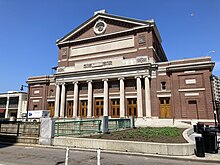
New England was an important center ofAmerican classical musicfor some time. TheFirst New England Schoolof composers was active between 1770 and 1820, and theSecond New England Schoolabout a century later. Prominent modernist composers also come from the region, includingCharles IvesandJohn Adams.Boston is the site of theNew England Conservatory,Boston Conservatory at Berklee,and theBoston Symphony Orchestra.
In popular music, the region has producedDonna Summer,JoJo,New Edition,Bobby Brown,Bel Biv Devoe,Passion Pit,MGMT,Meghan Trainor,New Kids on the Block,Rachel PlattenandJohn Mayer.In rock music, the region has producedRob Zombie,Aerosmith,Extreme,the Modern Lovers,Phish,thePixies,the Cars,the J. Geils Band,the Mighty Mighty Bosstones,Grace Potter,GG Allin,the Dresden Dolls,Dinosaur Jr.,theDropkick MurphysandBoston.Quincy, Massachusetts,nativeDick Dalehelped popularizesurf rock.Hip hop acts hailing from New England includeGang Starr,Apathy,Mr. LifandAkrobatik.
Media[edit]
The leading U.S. cable TV sports broadcasterESPNis headquartered inBristol, Connecticut.New England has several regional cable networks, includingNew England Cable News(NECN) and theNew England Sports Network(NESN). New England Cable News is the largest regional24-hourcable newsnetwork in the U.S., broadcasting to more than 3.2 million homes in all of the New England states. Its studios are located inNewton, Massachusetts,outside of Boston, and it maintains bureaus inManchester, New Hampshire;Hartford, Connecticut;Worcester, Massachusetts;Portland, Maine;andBurlington, Vermont.[161]In Connecticut, Litchfield, Fairfield, and New Haven counties it also broadcasts New York based news programs—this is due in part to the immense influence New York has on this region's economy and culture, and also to give Connecticut broadcasters the ability to compete with overlapping media coverage from New York-area broadcasters.
NESN broadcasts theBoston Red Soxbaseball andBoston Bruinshockey throughout the region, save for Fairfield County, Connecticut.[162]Connecticut also receives theYES Network,which broadcasts the games of theNew York YankeesandBrooklyn Netsas well asSportsNet New York(SNY), which broadcastsNew York Metsgames.
NBC Sports Bostonbroadcasts the games of theBoston Celtics,New England RevolutionandBoston Cannonsto all of New England except Fairfield County.
While most New England cities have daily newspapers,The Boston GlobeandThe New York Timesare distributed widely throughout the region. Major newspapers also includeThe Providence Journal,Portland Press Herald,andHartford Courant,the oldest continuously published newspaper in the U.S.[163]
Comedy[edit]
New Englanders are well represented in American comedy. Writers forThe Simpsonsand late-night television programs often come by way ofThe Harvard Lampoon.A number ofSaturday Night Live(SNL) cast members have roots in New England, fromAdam SandlertoAmy Poehler,who also starred in theNBCtelevision seriesParks and Recreation.Seth MacFarlane,the creator ofFamily Guy,is from Connecticut, with the show taking place in a fictional town called Quahog, Rhode Island. FormerDaily ShowcorrespondentsJohn Hodgman,Rob CorddryandSteve Carellare from Massachusetts. Carell was also involved in film andthe American adaptationofThe Office(alongside fellow Massachusetts nativesMindy Kaling,B. J. Novak,andJohn Krasinski), which featuresDunder-Mifflinbranches set inStamford, Connecticut,andNashua, New Hampshire.
Late-night television hostsJay LenoandConan O'Brienhave roots in the Boston area. Notable stand-up comedians are also from the region, includingBill Burr,Steve Sweeney,Steven Wright,Sarah Silverman,Lisa Lampanelli,Denis Leary,Lenny Clarke,Patrice O'NealandLouis CK.SNLcast memberSeth Meyersonce attributed the region's imprint on American humor to its "sort of wry New England sense of pointing out anyone who's trying to make a big deal of himself", withThe Boston Globesuggesting thatironyand sarcasm are its trademarks, as well as Irish influences.[164]
Literature[edit]

New Englanders have made significant contributions to literature. The first printing press in America was set up inCambridge, Massachusetts,byStephen Dayein the 17th century.[citation needed]Writers in New England produced many works on religious subjects, particularly on Puritan theology and poetry during colonial times and onEnlightenmentideas during the American Revolution. The literature of New England has had an enduring influence on American literature in general, with themes that are emblematic of the larger concerns of American letters, such as religion, race, the individual versus society, social repression and nature.[167]
19th century New England was a center for progressive ideals, and manyabolitionistandtranscendentalisttracts were produced. Leading transcendentalists were from New England, such asHenry David Thoreau,Ralph Waldo Emerson,andFrederic Henry Hedge.Hartford, Connecticut residentHarriet Beecher Stowe's novelUncle Tom's Cabinwas an influential book in the spread of abolitionist ideas and is said to have "laid the groundwork for theCivil War".[168]Other prominent New England novelists includeJohn Irving,Edgar Allan Poe,Louisa May Alcott,Sarah Orne Jewett,H. P. Lovecraft,Annie Proulx,Stephen King,Jack Kerouac,George V. Higgins,andNathaniel Hawthorne.
Boston was the center of the American publishing industry for some years, largely on the strength of its local writers and before it was overtaken by New York in the middle of the nineteenth century. Boston remains the home of publishersHoughton MifflinandPearson Education,and it was the longtime home of literary magazineThe Atlantic Monthly.Merriam-Websteris based inSpringfield, Massachusetts.Yankeeis a magazine for New Englanders based inDublin, New Hampshire.
Many New Englander poets have also been preeminent inAmerican poetry.Prominent poets includeHenry Wadsworth Longfellow,David Lindsay-Abaire,Annie Proulx,Edwin Arlington Robinson,Amy Lowell,John Cheever,Emily Dickinson,Elizabeth Bishop,Stanley Kunitz,E. E. Cummings,Edna St. Vincent Millay,Robert P. T. CoffinandRichard Wilbur.Robert Frostwho was described as an "artistic institution"[169]frequently wrote about rural New England life. TheConfessional poetrymovement features prominent New England writers includingRobert Lowell,Anne SextonandSylvia Plath.
Film, television, and acting[edit]
New England has a rich history infilmmakingdating back to the dawn of themotion pictureera at the turn of the 20th century, sometimes dubbedHollywood Eastby film critics. A theater at 547 Washington Street in Boston was the second location to debut a picture projected by theVitascope,and shortly thereafter several novels were being adapted for the screen and set in New England, includingThe Scarlet LetterandThe House of Seven Gables.[170]The New England region continued to churn out films at a pace above the national average for the duration of the 20th century, including blockbuster hits such asJaws,Good Will HuntingandThe Departed,all of which wonAcademy Awards.The New England area became known for a number of themes that recurred in films made during this era, including the development of yankee characters, smalltown life contrasted with city values, seafaring tales, family secrets and haunted New England.[171]These themes are rooted in centuries of New England culture and are complemented by the region's diverse natural landscape and architecture, from the Atlantic Ocean and brilliant fall foliage to church steeples and skyscrapers.
Since the turn of the millennium, Boston and the greater New England region have been home to the production of numerous films and television series, thanks in part to tax incentive programs put in place by local governments to attract filmmakers to the region.[172]

Notable actors and actresses that have come from the New England area includeBen Affleck,Matt Damon,Chris Evans,Ryan O'Neal,Amy Poehler,Elizabeth Banks,Steve Carell,Ruth Gordon,John Krasinski,Edward Norton,Mark WahlbergandMatthew Perry.Many films and television series have beenproduced in and set in New England.
Museums, historical societies, and libraries[edit]

There are many museums located throughout New England, especially in theGreater Bostonarea. These museums include privately held collections as well as public institutions. Most notable of these museums are theMuseum of Fine Arts,theInstitute of Contemporary Art, Boston,theIsabella Stewart Gardner Museum,Worcester Art Museum,and thePeabody Essex Museum.The oldest public museum in continuous operation in the United States is thePilgrim Hall MuseuminPlymouth, Massachusetts,which opened in 1824.
TheBoston Public Libraryis the largest public library in the region with over 8 million materials in its collection. The largest academic research library in the world is theHarvard LibraryinCambridge, Massachusetts.TheW. E. B. Du Bois Libraryof theUniversity of Massachusetts Amherstis the tallest academic library in the world.[173]
There are also manyhistorical societiesin the region.Historic New Englandoperates museums and historic sites in the name of historical preservation. Many properties belonging to HNE include preservedhouse museumsof prominent figures in New England and American history. Other societies include theMassachusetts Historical Society,theEssex Institute,theAmerican Antiquarian Society,andThe Bostonian Society.The Massachusetts Historical Society, founded in 1791, is the oldest operating in the United States.[174]Many cities and towns across New England operate their own historical societies focused on historical preservation of local sites and the recording of local history.
Sports[edit]
New England has a strong heritage of athletics, and many internationally popular sports were invented and codified in the region, includingbasketball,volleyball,andAmerican football.
Football is the most popular sport in the region and was developed byWalter CampinNew Haven, Connecticut,in the 1870s and 1880s. TheNew England Patriotsare based inFoxborough, Massachusetts,and are the most popular professional sports team in New England. The Patriots have won sixSuper Bowlchampionships and are one of the most winning teams in theNational Football League.There are also high-profile collegiate and high school football rivalries in New England. These games are most often played onThanksgiving Dayand are some of the oldest sports rivalries in the United States. The high school rivalry betweenWellesley High SchoolandNeedham High Schoolin Massachusetts is considered to be the nation's oldest football rivalry, having started in 1882.[175][176][177][178]
Before the advent of modern rules of baseball, a different form was played calledthe Massachusetts Game.This version of baseball was an early rival of theKnickerbocker Rulesof New York and was played throughout New England. In 1869, there were 59 teams throughout the region which played according to the Massachusetts rules. The New York rules gradually became more popular throughout the United States, and professional and semi-professional clubs began to appear. Early teams included theProvidence Grays,theWorcester Worcestersand theHartford Dark Blues;these did not last long, but other teams grew to renown, such as theBoston Bravesand theBoston Red Sox.Fenway Park was built in 1912 and is the oldest ballpark still in use in Major League Baseball.[179]Other professional baseball teams in the region include theHartford Yard Goats,New Hampshire Fisher Cats,Vermont Lake Monsters,Portland Sea Dogs,Bridgeport Bluefish,New Britain Beesand theWorcester Red Sox.[180][181]
Basketball was developed inSpringfield, Massachusetts,byJames Naismithin 1891. Naismith was attempting to create a game which could be played indoors so that athletes could keep fit during New England winters. TheBoston Celticswere founded in 1946 and are the most successfulNBAteam, winning 18 titles. TheNBA G Leagueteam theMaine Red Clawsis based inPortland, Maine.TheWomen's National Basketball Association'sConnecticut Sunis based inUncasville, Connecticut.TheUConn Huskies women's basketballteam is the most successful women's collegiate team in the nation, winning 11 NCAA Division I titles. TheBasketball Hall of Fameis located in Springfield, Massachusetts.
Winter sports are extremely popular and have a long history in the region, includingalpine skiing,snowboarding,andNordic skiing.Ice hockeyis also a popular sport. TheBoston Bruinswere founded in 1924 as anOriginal Sixteam, and they have a historic rivalry with theMontreal Canadiens.The Bruins play in theTD Garden,a venue that they share with the Boston Celtics. College hockey is also a popular spectator sport, with Boston's annualBeanpottournament betweenNortheastern University,Boston University,Harvard UniversityandBoston College.Other hockey teams include theMaine Mariners,Providence Bruins,Springfield Thunderbirds,Worcester Railers,Bridgeport Sound Tigersand theHartford Wolf Pack.TheConnecticut Whalehockey team and theBoston Prideare two of the six teams of thePremier Hockey Federation.The region's largest ice hockey and skating facility is theNew England Sports CenterinMarlborough, Massachusetts,home to theSkating Club of Boston,one of the oldest ice skating clubs in the United States.[182][183]
Volleyball was invented inHolyoke, Massachusetts,in 1895 byWilliam G. Morgan.Morgan was an instructor at aYMCAand wanted to create an indoor game for his athletes. The game was based onbadmintonand was spread as a sport through YMCA facilities. The internationalVolleyball Hall of Fameis located in Holyoke.
Rowing, sailing, and yacht racing are also popular events in New England. TheHead of the Charlesrace is held on theCharles Riverin October every year and attracts over 10,000 athletes and over 200,000 spectators each year. Sailing regattas include theNewport Bermuda Race,theMarblehead to Halifax Ocean Race,and theSingle-Handed Trans-Atlantic Race.TheNew York Timesconsiders the Newport and Marblehead races to be among the most prestigious in the world.[184]
TheBoston Marathonis run onPatriots' Dayevery year and was first run in 1897. It is aWorld Marathon Majorand is operated by theBoston Athletic Association.The race route goes fromHopkinton, Massachusetts,throughGreater Boston,finishing atCopley Squarein Boston. The race offers far less prize money than many other marathons, but its difficulty and long history make it one of the world's most prestigious marathons.[185]It is New England's largest sporting event with nearly 500,000 spectators each year.[186]
New England is represented in the top level of American professional soccer by theNew England Revolution,an inaugural team of theMajor League Soccerfounded in 1994 and playing inGillette Stadiumwhich it shares with the New England Patriots. The Revolution have won aU.S. Open Cupand aSuperLiga Championship,and they have appeared in five MLS finals. In theUSL Championship,the second division on the American soccer pyramid, New England is represented byHartford Athleticwhich was founded in 2019 and plays its games atDillon Stadium.
-
Harvard vs. Yale football game in 2003
-
TheNew England Patriotsare the most popular professional sports team in New England.
-
TheMiddlebury Collegerowing team in the 2007Head of the Charles Regatta
Transportation[edit]

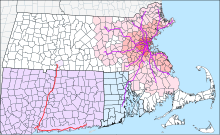
Each of the New England states has its own Department of Transportation which plans and develops systems for transport, though some transportation authorities operate across state and municipal lines. TheMassachusetts Bay Transportation Authority(MBTA) oversees public transportation in the Greater Boston area. It is the largest such agency and operates throughout eastern Massachusetts and into Rhode Island. The MBTA oversees the oldest subway system (theTremont Street subway) and the second most-used light rail line (theGreen Line) in the United States, as well as one of five remainingtrolleybus systemsnationwide.Coastal Connecticutmakes use of theMetropolitan Transportation Authorityof New York due to the connection of that region to New York's economy. The MTA operates theMetro-North Railroadin coordination with theConnecticut Department of Transportation.CTrailis a division of the Connecticut Department of Transportation which operates theShore Line Eastalong its southern coast, terminating inOld SaybrookandNew London.It also operates theHartford Line,leading south toNew Havenand north toSpringfield.Commuter rail service is provided north of Springfield toGreenfield, Massachusetts,as part of theValley FlyerAmtrak route.
Amtrak provides interstate rail service throughout New England. Boston is the northern terminus of theNortheast Corridor.TheVermonterconnects Vermont to Massachusetts and Connecticut, while theDowneasterlinks Maine to Boston. The long-distanceLake Shore Limitedtrain has two eastern termini after splitting inAlbany,one of which is Boston. This provides rail service on the formerBoston and Albany Railroadwhich runs between its namesake cities. The rest of theLake Shore Limitedcontinues to New York City.
Bus transportation is available in most urban areas and is governed by regional and local authorities. ThePioneer Valley Transit Authorityand theMetroWest Regional Transit Authorityare examples of public bus transportation which support more suburban and rural communities.
South Stationin Boston is a major center for bus, rail, and light rail lines. Major interstate highways traversing the region includeI-95,I-93,I-91,I-89,I-84,andI-90(theMassachusetts Turnpike).Logan Airportis the busiest transportation hub in the region in terms of number of passengers and total cargo, opened in 1923 and located inEast BostonandWinthrop, Massachusetts.It is a hub forCape AirandDelta Air Lines,and a focus city forJetBlue.It is the16th busiestairport in the United States. Other airports in the region includePatrick Leahy Burlington International Airport,Bradley International Airport,Rhode Island T. F. Green International Airport,Manchester–Boston Regional Airport,andPortland International Jetport.
See also[edit]
- Atlantic Northeast
- Autumn in New England
- Brother Jonathan
- Extreme points of New England
- Fieldstone
- Historic New England
- List of beaches in New England
- List of birds of New England
- List of mammals of New England
- List of people from New England
- Manor of East Greenwich
- New Albion
- New Albion (colony)
- New England–Acadian forests
- New England Confederation
- New England (medieval)
- New England Planters
- New England Summer Nationals
- Northeastern coastal forests
- Offshore wind power
- Southeastern New England AVAwine region
- Swamp Yankee
References[edit]
Citations[edit]
- ^"Yankee".The American Heritage Dictionary.Boston, MA: Houghton Mifflin Company. 2000.RetrievedMarch 28,2011.
- ^"Novanglian".Merriam-Webster.RetrievedMay 11,2023.
- ^"GDP by State".GDP by State | U.S. Bureau of Economic Analysis (BEA).Bureau of Economic Analysis.RetrievedApril 10,2022.
- ^Chiu, Monica (2009).Asian Americans in New England: Culture and Community.Lebanon, NH: University of New Hampshire Press. p. 44.ISBN9781584657941.RetrievedOctober 12,2016.
- ^abcdBain, Angela Goebel; Manring, Lynne; and Mathews, Barbara.Native Peoples in New England.Retrieved July 21, 2010, from Pocumtuck Valley Memorial Association.
- ^"Abenaki History".abenakination.org.RetrievedMarch 28,2011.
- ^Allen, William (1849).The History of Norridgewock.Norridgewock ME: Edward J. Peet. p.10.ISBN9780665608186.RetrievedMarch 28,2011.
Norridgewock history.
- ^Wiseman, Fred M."The Voice of the Dawn: An Autohistory of the Abenaki Nation".p. 70.RetrievedMarch 28,2011.
- ^"What are the oldest cities in America?".Glo-con. Archived fromthe originalon September 28, 2007.RetrievedAugust 11,2007.
- ^Cressy, David (1987).Coming Over: Migration and Communication Between England and New England in the Seventeenth Century.p. 4.Cambridge University Press.
- ^Swindler, William F., ed;Sources and Documents of United States Constitutions10 Volumes; Dobbs Ferry, New York; Oceana Publications, 1973–1979. Volume 5: pp. 16–26.
- ^"joint stock company organized in 1620 by a charter from the British crown with authority to colonize and govern the area now known as New England." New England, Council for. (2006). InEncyclopædia Britannica.Retrieved July 13, 2006, from Encyclopædia Britannica Premium Service:BritannicaArchivedFebruary 12, 2005, at theWayback Machine
- ^Haxtun, Anne Arnoux (1896).Signers of the Mayflower Compact, vol. 1.New York: The Mail and Express Publishing Company.RetrievedMarch 29,2011.
- ^Townsend, Edward Waterman (1906).Our Constitution: How and Why It Was Made.New York: Moffat, Yard & Company. p.42.RetrievedMarch 29,2011.
mayflower compact.
- ^Secretary of the Commonwealth of Massachusetts."Public Records: The History of the Arms and Great Seal of the Commonwealth of Massachusetts".sec.state.ma.us.RetrievedMarch 29,2011.
- ^Northend, William Dummer (1896).The Bay Colony: A Civil, Religious and Social History of the Massachusetts Colony.Boston: Estes and Lauriat. p.305.
charter.
- ^"History of Boston, Massachusetts".U-S-History.RetrievedAugust 17,2016.
- ^State of Connecticut."About Connecticut".CT.gov. Archived fromthe originalon April 29, 2011.RetrievedMarch 28,2011.
- ^Peace, Nancy E. (November 1976)."Roger Williams—A Historiographical Essay"(PDF).Rhode Island History.Providence RI: The Rhode Island Historical Society. pp. 103–115.RetrievedMarch 28,2011.
- ^"History & Famous Rhode Islanders".Rhode Island Tourism Division.RetrievedMarch 28,2011.
- ^Hall, Hiland (1868).The History of Vermont: From Its Discovery to Its Admission into the Union.Albany NY: Joel Munsell. p.3.
history of vermont.
- ^"1637 - The Pequot War".The Society of Colonial Wars in the State of Connecticut.RetrievedDecember 14,2013.
- ^Howe, Daniel Wait (1899).The Puritan Republic of the Massachusetts Bay in New England.Indianapolis: Bowen-Merrill. pp.308–311.
- ^"1675 - King Philip's War".The Society of Colonial Wars in the State of Connecticut.RetrievedDecember 14,2013.
- ^Peterson, Mark A. (2019).The City-State of Boston: The Rise and Fall of an Atlantic Power, 1630-1865.Princeton, New Jersey: Princeton University Press. pp. 129–133.Project MUSEbook 64409.
- ^Newell, Margret Ellen (2015).Brethren by Nature: New England Indians, Colonists, and the Origins of American Slavery.Ithaca, New York: Cornell University Press. pp. 1–158.Project MUSEbook 57597.
- ^Newell, M. E. (2009). "Indian slavery in colonial America." In A. Gallay (Ed.),Indian slavery in colonial America(pp. 33-66). University of Nebraska Press.
- ^See theFrench and Indian Warsas well asFather Rale's WarandFather Le Loutre's Warfor more information.
- ^Morison, Samuel Eliot(1972).The Oxford History of the American People.New York City: Mentor. p. 112.ISBN0-451-62600-1.
- ^Martucci, David B."The New England Flag".D. Martucci. Archived fromthe originalon April 1, 2007.RetrievedJuly 25,2008.
- ^"Flags of the Early North American Colonies and Explorers".Historical Flags of Our Ancestors.
- ^Leepson, Marc (2007).Flag: An American Biography.New York: Thomas Dunne Books. p. 14.ISBN9781429906470.
- ^Various (1908).Proceedings of the First New England Conference: Called by the Governors of the New England States, Boston, Nov. 23, 24, 1908.Boston: Wright & Potter Printing Company. p. 6.
- ^Preble, George Henry (1880).History of the Flag of the United States of America: And of the Naval and Yacht-club Signals, Seals, and Arms, and Principal National Songs of the United States, with a Chronicle of the Symbols, Standards, Banners, and Flags of Ancient and Modern Nations.Boston: A. Williams. p.190.
- ^Stark, Bruce P."The Dominion of New England".Connecticut Humanities Council.RetrievedMarch 30,2011.
- ^Palfrey, John Gorham (1865).History of New England, vol. 3.Boston: Little, Brown, and Company. pp. 561–590.RetrievedMarch 30,2011.
- ^Palfrey, John Gorham (1873).A Compendious History of New England, vol. 3.Boston: H.C. Shepard.RetrievedMarch 30,2011.
- ^Wesley Frank Craven,Colonies in Transition, 1660 – 1713(1968). p. 224.
- ^"The Equivalent Lands and Fort Dummer".Brattleboro History.Valley Historians. Archived fromthe originalon September 15, 2017.RetrievedMarch 10,2017.
- ^Harper, Douglas."Slavery in New Hampshire".Slavenorth.RetrievedAugust 17,2016.
- ^"Yankeeland".The Random House Dictionary.Boston: Random House. 2013.RetrievedSeptember 5,2013.
- ^Library of Congress."Missouri Compromise: Primary Documents of American History".Library of Congress.RetrievedMarch 30,2011.
- ^"New England".Encyclopædia Britannica.RetrievedOctober 16,2010.
- ^James Schouler,History of the United States, Vol. 1(New York: Dodd, Mead & Company. 1891; copyright expired)
- ^Dwight, Theodore (1833).History of the Hartford Convention.New York: N. & J. White.RetrievedMarch 30,2011.
hartford convention.
- ^Hickey, Donald R.The War of 1812: A Forgotten Conflict.University of Illinois Press.p. 233.
- ^Cooper, Thomas Valentine; Fenton, Hector Tyndale (1884).American Politics (Non-Partisan) from the Beginning to Date, Book III.Chicago: C. R. Brodix. pp. 64–69.
- ^"New England",Microsoft EncartaOnline Encyclopedia 2006.New England - Further Reading - MSN Encarta.Archived fromthe originalon October 13, 2006.RetrievedNovember 22,2009.
- ^"History & Culture: Birthplace of the American Industrial Revolution".Blackstone River Valley National Heritage Corridor, MA, RI.National Park Service. June 11, 2009.RetrievedApril 4,2016.
- ^Bagnall, William R.The Textile Industries of the United States: Including Sketches and Notices of Cotton, Woolen, Silk, and Linen Manufacturers in the Colonial Period. Vol. I.pg. 97. The Riverside Press, 1893.
- ^"Forging Arms for the Nation".Springfield Armory National Historic Site, Massachusetts.National Park Service.RetrievedApril 4,2016.
- ^Coen, Scott (May 13, 2011)."The Springfield Armory: The Heartbeat of the 19th Century Industrial Revolution".MassLive.RetrievedApril 4,2016.
- ^Rooker, Sarah."The Industrial Revolution: Connecticut River Valley Overview".Teaching the Industrial Revolution.The Flow of History. Archived fromthe originalon March 5, 2016.RetrievedApril 4,2016.
- ^Dublin, Thomas. "Lowell Millhands".Transforming Women's Work(1994) pp. 77–118.
- ^ab"Census Data for Year 1850".Historical Census Browser.University of Virginia Library. Archived fromthe originalon April 24, 2016.RetrievedApril 4,2016.
- ^Wyatt-Brown, Bertram."American Abolitionism and Religion".Divining America: Religion in American History.National Humanities Center TeacherServe.RetrievedApril 4,2016.
- ^abTarr, David; Benenson, Bon (2012).Elections A to Z.Thousand Oaks, CA: CQ Press. p. 542.ISBN978-0-87289-769-4.RetrievedApril 19,2015.
- ^"Senate: Friday March 31, 1933"(PDF).Congressional Record–Senate.p. 1069.RetrievedAugust 30,2021.
- ^Thorndike, Joseph J. (November 10, 2003)."Historical Perspective: Pecora Hearings Spark Tax Morality, Tax Reform Debate".taxhistory.org.RetrievedAugust 30,2021.
- ^431 Days: Joseph P. Kennedy and the Creation of the SEC (1934-35)(Progressive Reform and the Securities Act) | Galleries | Virtual Museum and Archive of the History of Financial Regulation (sechistorical.org)
- ^Minchin, Timothy J. (2013). "The Crompton Closing: Imports and the Decline of America's Oldest Textile Company".Journal of American Studies.47(1): 231–260.doi:10.1017/S0021875812000709.S2CID145693630.
- ^Henry Etzkowitz,MIT and the Rise of Entrepreneurial Science(Routledge2007)
- ^David Koistinen,Confronting Decline: The Political Economy of Deindustrialization in Twentieth-Century New England(2013)
- ^Bishaw, Alemayehu; Iceland, John (May 2003)."Poverty: 1999"(PDF).Census 2000 Brief.US Census Bureau.RetrievedAugust 17,2016.
- ^"Income in the Past 12 Months (in 2014 Inflation-Adjusted Dollars): 2014 American Community Survey 1-Year Estimates (S1901)".American Factfinder.United States Census Bureau. Archived fromthe originalon February 13, 2020.RetrievedApril 4,2016.
- ^"State Area Measurements and Internal Point Coordinates".United States Census Bureau.RetrievedFebruary 3,2022.
- ^"Part 1: Population and Housing Unit Counts"(PDF).2000 Census of Population and Housing – United States Summary: 2000.United States Census Bureau. April 2004.RetrievedApril 4,2016.
- ^"The British Isles and all that..."Heriot-Watt University,Edinburgh.RetrievedMarch 7,2011.
- ^"State Area Measurements and Internal Point Coordinates".Geography Division, U.S. Census Bureau.RetrievedMay 13,2021.
- ^"Glacial Features of the Exotic Terrane".The Teacher-Friendly Guide to the Earth Science of the Northeastern US.Paleontological Research Institution.RetrievedApril 4,2016.
- ^abcdEmerson, Philip (1922).The Geography of New England.New York:The Macmillan Company.RetrievedMarch 28,2011.
- ^"Physiographic divisions of the conterminous U.S."U.S. Geological Survey.RetrievedDecember 23,2011.
- ^"Topography of the Appalachian/Piedmont Region 2".The Teacher-Friendly Guide to the Earth Science of the Northeastern US.Paleontological Research Institution.RetrievedApril 4,2016.
- ^Shaw, Ethan."The 10 Tallest Mountains East of the Mississippi".USA Today.RetrievedApril 4,2016.
- ^"World Record Wind".Mount Washington Observatory.Archived fromthe originalon May 5, 2012.RetrievedApril 4,2016.
- ^"World Record Wind Gust: 408 km/h".World Meteorological Organization.January 22, 2010. Archived fromthe originalon July 22, 2011.RetrievedMay 27,2011.
- ^"About Us".Mount Washington Observatory.Archived fromthe originalon October 23, 2014.RetrievedApril 4,2016.
- ^Hrin, Eric (March 26, 2011)."Wolfe turns love of books into career; One-hundredth anniversary of library in Troy approaching".The Daily Review.Towanda, PA. Archived fromthe originalon July 30, 2012.RetrievedMay 28,2011.
- ^"New England's Fall Foliage".Discover New England. Archived fromthe originalon August 16, 2007.RetrievedMay 28,2011.
- ^DeGraaf, Richard M.; Miller, Ronald I. (1996),"The importance of disturbance and land-use history in New England: Implications for forested landscapes and wildlife conservation",Conservation of Faunal Diversity in Forested Landscapes,Dordrecht: Springer Netherlands, pp. 3–35,doi:10.1007/978-94-009-1521-3_1,ISBN978-94-010-7180-2,retrievedJune 5,2023
- ^Pan, Yude; McCullough, Kevin; Hollinger, David Y. (March 7, 2018)."Forest biodiversity, relationships to structural and functional attributes, and stability in New England forests".Forest Ecosystems.5(1): 14.Bibcode:2018FoEco...5...14P.doi:10.1186/s40663-018-0132-4.ISSN2197-5620.S2CID256431037.
- ^ab"Annual Estimates of the Resident Population: April 1, 2010 to July 1, 2015 - United States -- Metropolitan and Micropolitan Statistical Area: 2015 Population Estimates (GCT-PEPANNRES)".American Factfinder.U.S. Census Bureau. Archived fromthe originalon February 13, 2020.RetrievedApril 4,2016.
- ^"Annual Estimates of the Resident Population for Incorporated Places: April 1, 2010 to July 1, 2014".U.S. Census Bureau. Archived fromthe originalon May 22, 2015.RetrievedApril 4,2016.
- ^"TIGERweb".U.S. Census Bureau. (Combined Statistical Areas checkbox).RetrievedApril 4,2016.
- ^"Montpelier".Fodor's.April 1, 2016.RetrievedMarch 19,2021.
- ^ab"Change in Resident Population of the 50 States, the District of Columbia, and Puerto Rico: 1910 to 2020"(PDF).United States Census Bureau.RetrievedJune 13,2021.
- ^Martin, Joyce A.; Hamilton, Brady E.; Sutton, Paul D.; Ventura, Stephanie J.; Mathews, T.J.; Osterman, Michelle J.K. (December 8, 2010)."Births: Final Data for 2008"(PDF).National Vital Statistics Reports.59(1): 1, 3–71.PMID22145497.RetrievedApril 4,2016.
- ^ab"Hispanic or Latino Origin by Specific Origin: 2014 American Community Survey 1-Year Estimates: New England Division (B03001)".American Factfinder.U.S. Census Bureau. Archived fromthe originalon February 13, 2020.RetrievedApril 4,2016.
- ^"People Reporting Ancestry: 2014 American Community Survey 1-Year Estimates: New England Division (B04006)".American Factfinder.U.S. Census Bureau. Archived fromthe originalon February 13, 2020.RetrievedApril 4,2016.
- ^Includes English and "British" but not Scottish or Welsh.
- ^de Oliveira, Judy; Gubitosi, Patricia (November 16, 2021)."The motivations of heritage and non-heritage students in learning portuguese in L(USA)land".Language Awareness.31(2): 213–231.doi:10.1080/09658416.2021.2000996.ISSN0965-8416.S2CID244283614.
- ^ab"Language Spoken at Home: 2014 American Community Survey 1-Year Estimates: New England Division (S1601)".American Factfinder.U.S. Census Bureau. Archived fromthe originalon February 13, 2020.RetrievedApril 4,2016.
- ^"Language Spoken at Home by Ability to Speak English for the Population 5 Years and Over: 2014 American Community Survey 1-Year Estimates: New England Division (B16001)".American Factfinder.U.S. Census Bureau. Archived fromthe originalon February 13, 2020.RetrievedApril 4,2016.
- ^"Selected Characteristics of the Native and Foreign-Born Populations: 2014 American Community Survey 1-Year Estimates: New England Division (S0501)".American Factfinder.U.S. Census Bureau. Archived fromthe originalon February 13, 2020.RetrievedApril 4,2016.
- ^Monica Chiu, ed.Asian Americans in New England: Culture and Community(University of New Hampshire Press, 2009) 252 pp.
- ^"Place of Birth for the Foreign-Born Population in the United States: 2014 American Community Survey 1-Year Estimates: New England Division (B05006)".American Factfinder.U.S. Census Bureau. Archived fromthe originalon February 13, 2020.RetrievedApril 4,2016.
- ^"Annual Estimates of the Resident Population: April 1, 2010 to July 1, 2015 - United States -- Combined Statistical Area: 2015 Population Estimates (GCT-PEPANNRES)".American Factfinder.U.S. Census Bureau. Archived fromthe originalon February 13, 2020.RetrievedApril 4,2016.
- ^"Background on the New England Economy".U.S. Department of Commerce. Archived fromthe originalon September 19, 2002.
- ^"Regional Data: GDP & Personal Income".Bureau of Economic Analysis.U.S. Department of Commerce. Archived fromthe originalon January 17, 2013.RetrievedSeptember 21,2014.
- ^Rich, Jack C. (1988).Materials and Methods of Sculpture.Dover Publications.
- ^"The Global Financial Centres Index 21"(PDF).Long Finance. March 2017. Archived fromthe original(PDF)on June 11, 2017.
- ^Yeandle, Mark (March 2011)."The Global Financial Centres Index 9"(PDF).The Z/Yen Group.p. 4. Archived fromthe original(PDF)on November 28, 2012.RetrievedJanuary 31,2013.
- ^"History of Boston's Economy – Growth and Transition 1970–1998"(PDF).Boston Redevelopment Authority. November 1999. p. 9. Archived fromthe original(PDF)on July 23, 2013.RetrievedMarch 12,2013.
- ^Morris, Marie (2006).Frommer's Boston 2007(2 ed.). John Wiley & Sons. p. 59.ISBN978-0-470-08401-4.
- ^"General Electric To Move Corporate Headquarters To Boston".CBS Local Media. January 13, 2016.RetrievedJanuary 15,2016.
- ^"Top shoe brands, like Reebok and Converse, move headquarters to Boston".Omaha.RetrievedJanuary 19,2017.
- ^"Reebok Is Moving to Boston".Boston Magazine.Archived fromthe originalon October 23, 2017.RetrievedJanuary 19,2017.
- ^STAFF, COURANT."Connecticut Has 19 Companies On Fortune 500 List".courant.RetrievedMay 19,2017.
- ^"Maine State Agriculture Overview - 2004"(PDF).USDA National Agricultural Statistics Service. Archived fromthe original(PDF)on March 5, 2006.
- ^"Vermont State Agriculture Overview - 2006"(PDF).USDA National Agricultural Statistics Service. Archived fromthe original(PDF)on July 22, 2006.
- ^"Connecticut State Agriculture Overview - 2005"(PDF).USDA National Agricultural Statistics Service. Archived fromthe original(PDF)on November 1, 2006.RetrievedNovember 14,2006.
- ^"Massachusetts State Agriculture Overview - 2005"(PDF).USDA National Agricultural Statistics Service. Archived fromthe original(PDF)on November 10, 2006.RetrievedNovember 14,2006.
- ^U.S. Department of Energy."State Energy Profiles: State Rankings - State Ranking 7. Total Energy Consumed per Capita, 2013 (million Btu)".RetrievedApril 4,2016.
- ^U.S. Department of Energy."State Energy Profiles: State Rankings - State Ranking 9. Average Retail Price of Electricity to Residential Sector, December 2015 (cents/kWh)".RetrievedApril 4,2016.
- ^"National Conference of State Legislatures State Unemployment Rates 2015"(PDF).National Conference of State Legislatures. Archived fromthe original(PDF)on February 24, 2017.RetrievedFebruary 24,2017.
- ^"Unemployment Rates for States".Bureau of Labor Statistics.United States Government.RetrievedMarch 17,2015.
- ^"New England — Labor Force Statistics".U.S. Department of Labor. Archived fromthe originalon October 18, 2011.RetrievedDecember 18,2011.
- ^McCann, Adam."2023's Tax Burden by State".WalletHub.
- ^De Tocqueville, Alexis.Democracy in America.Quotation attributed at[1]ArchivedJune 7, 2010, at theWayback Machine.Retrieved July 20, 2010.
- ^Madison, James.Federalist No. 55.Quotation attributed atIlsr.orgArchivedJanuary 13, 2020, at theWayback Machine.Retrieved July 19, 2006.
- ^See Harvard lecturer Robert I. Rotberg reviewReal Democracy: the New England town meeting and how it worksatDemocraciaparticipativa.net(Retrieved July 19, 2006)(in Spanish and English).ArchivedSeptember 28, 2007, at theWayback Machine
- ^"New England USA Quick Facts".Discover New England. Archived fromthe originalon August 12, 2015.RetrievedApril 4,2016.
- ^"Wyoming, Mississippi, Utah Rank as Most Conservative States".Gallup. August 2, 2010.RetrievedDecember 31,2013.
- ^"Presidential Election Results: Biden Wins".The New York Times.November 3, 2020.RetrievedApril 17,2021.
- ^"Election Center 2008".CNN.RetrievedOctober 4,2008.
- ^Salzman, Avi (December 18, 2005)."A Laboratory for Liberals?".New York Times.RetrievedApril 4,2016.
- ^"New England grapples with first execution".Concord Monitor.May 13, 2005. Archived fromthe originalon May 15, 2011.RetrievedJuly 20,2010.
- ^Grynbaum, Michael M. (June 8, 2006)."Gregg cites states' rights in voting against amendment".Boston Globe.RetrievedApril 4,2016.
- ^Jones, Jeffrey M. (February 4, 2015)."Massachusetts, Maryland Most Democratic States".Gallup.RetrievedApril 4,2016.
- ^Kazin, Michael; Edwards, Rebecca; Rothman, Adam (2011).The Concise Princeton Encyclopedia of American Political History.Princeton University Press. pp. 360–365.ISBN978-1400839469.
- ^Purple, Matt (April 1, 2010)."No More 'New England Republicans'".The American Spectator.Archived fromthe originalon December 15, 2013.RetrievedApril 4,2016.
- ^"Mike Huckabee: Mike Huckabee's Weekly Schedule for Sept. 24".All American Patriots website.September 25, 2007. Archived fromthe originalon March 21, 2012.RetrievedMarch 21,2012.
- ^Muther, Christopher (July 1, 2010)."Prepping for a party".The Boston Globe.RetrievedApril 4,2016.
- ^"Boston Latin School".Encyclopædia Britannica Online.March 22, 2024.
- ^Varhola, Michael (2011).Life in Civil War America.F+W Media.ISBN9781440310881.RetrievedJune 22,2012.[permanent dead link]
- ^"FRBB: New England Economic Review".Federal Reserve Bank of Boston. Archived fromthe originalon December 10, 1997.RetrievedJuly 25,2008.
- ^"UConn Poll: New Englanders & Regional Identity".news.uconn.edu.Archived fromthe originalon June 13, 2010.RetrievedApril 8,2020.
- ^McWilliams, John P. (2004).New England's Crises and Cultural Memory.Cambridge: Cambridge University Press.ISBN9781139453738.RetrievedApril 4,2016.
new england's crises and cultural memory.
- ^abcFischer, David Hackett(1991).Albion's Seed: Four British Folkways in America.Oxford University Press US.ISBN0195069056.RetrievedApril 4,2016.
- ^"New England Population History".Brown University. Archived fromthe originalon September 5, 2008.RetrievedAugust 26,2008.
- ^"Is Connecticut Part of New England? - Yankee Magazine".New England Today.June 13, 2016.RetrievedAugust 1,2022.
- ^"Why Is Connecticut Always Excluded from Talk of New England?".Boston Magazine.January 18, 2022.RetrievedAugust 1,2022.
- ^Newport, Frank (January 28, 2009)."State of the States: Importance of Religion".Gallup.RetrievedApril 4,2016.
- ^abKosmin, Barry A.; Keysar, Ariela (March 2009)."ARIS 2008 Report: Part IIIC – Geography and Religion"(PDF).American Religious Identification Survey.RetrievedApril 4,2016.
- ^ Starbuck, Alexander (1878).History of the American Whale Fishery from its Earliest Inception to the Year 1876.Waltham, Mass.:Alexander Starbuck.RetrievedOctober 8,2014.
- ^Kamila, Avery Yale (November 8, 2020)."Americans have been enjoying nut milk and nut butter for at least 4 centuries".Portland Press Herald.RetrievedJanuary 6,2021.
- ^Tucker, Aimee (September 12, 2019)."75 Classic New England Foods".New England Today.
- ^Noel, Josh (July 5, 2017)."How I learned to stop worrying and love hazy IPA — some hazy IPA".chicagotribune.
- ^Jason & Todd Alström."It's Official: New England India Pale Ale Is a Style".BeerAdvocate.
- ^Whittle, Patrick (August 28, 2018)."Coca-Cola acquires Moxie, a soda brand that is beloved in Maine".USA Today.RetrievedJanuary 26,2019.
- ^"Autocrat - A Swallow Will Tell You".Rhode Tour.RetrievedMarch 29,2018.
- ^"Annual Portuguese Feast of the Blessed Sacrament".Discovernewengland.org.Archived fromthe originalon November 24, 2020.RetrievedAugust 18,2020.
- ^"Common Traits of the Boston Accent".Boston.RetrievedJanuary 3,2018.
- ^Metcalf, Allan.How We Talk: American Regional English Today.Houghton Mifflin.Archived fromthe originalon September 16, 2008.RetrievedSeptember 17,2008.
- ^"Guide to Rhode Island Language Stuff".Quahog.org. Archived fromthe originalon July 14, 2007.RetrievedMay 30,2007.
- ^Nelson, Jennifer (April 27, 2007)."New England's best ice cream".The Boston Globe.Archived fromthe originalon July 18, 2008.RetrievedJanuary 14,2008.
- ^"Surviving the New England Winter: You Scream, I Scream, Ice Cream!".The Harvard Harbus.December 5, 2005. Archived fromthe originalon April 18, 2016.RetrievedApril 4,2016.
- ^Angelotti, Silvio."History of Candlepin Bowling".Massachusetts Bowling Association. Archived fromthe originalon August 26, 2007.RetrievedAugust 23,2007.
- ^"About New England Cable News".Boston.Archived fromthe originalon December 16, 2013.RetrievedJuly 19,2006.
- ^"Frequently Asked Questions".New England Sports Network.Boston. Archived fromthe originalon November 7, 2005.RetrievedNovember 7,2005.
- ^"Older Than the Nation".Hartford Courant.Archived fromthe originalon April 15, 2009.RetrievedApril 4,2016.
- ^Page, Janice (January 25, 2004)."What's So Funny?".Boston.RetrievedJanuary 27,2010.
- ^Kemp, John C.Robert Frost and New England: The Poet As Regionalist.Princeton University Press, 1979. JSTOR, jstor.org/stable/j.ctt13x0t68.
- ^Foundation, Poetry (April 7, 2020)."Robert Frost".Poetry Foundation.RetrievedApril 8,2020.
- ^Gates, David (June 29, 2006)."Destination: New England".Salon.RetrievedApril 4,2016.
- ^Kaufman, Will (2006).The Civil War in American Culture.Edinburgh University Press.p. 18.ISBN9780748619351.
- ^Contemporary Literary Criticism.Ed. Jean C. Stine, Bridget Broderick, and Daniel G. Marowski. Vol. 26. Detroit: Gale Research, 1983. p110
- ^Kharfen, Stephen."A History of Boston Films"(PDF).Archived fromthe original(PDF)on September 5, 2014.RetrievedFebruary 24,2014.
- ^Sheldon, Karan."New England in Feature Films".Archived fromthe originalon September 22, 2014.RetrievedFebruary 24,2014.
- ^Rotella, Carlo."Hollywood on the Charles: Why the movie industry is crazy for Boston".Boston Magazine. Archived fromthe originalon January 6, 2014.RetrievedDecember 13,2013.
- ^"Library World Records | Books | Libraries".Scribd.RetrievedApril 8,2020.
- ^"Massachusetts Historical Society: About the MHS".masshist.org.RetrievedApril 8,2020.
- ^"The Secret History of the Needham-Wellesley Game | Needham History Center & Museum".needhamhistory.org.Archived fromthe originalon April 4, 2020.RetrievedApril 8,2020.
- ^"Wellesley (Mass.) wins latest edition of nation's oldest Thanksgiving football rivalry".November 23, 2017.RetrievedApril 8,2020.
- ^"Ranking the Top 25 Rivalries in College Football History".AthlonSports.RetrievedApril 8,2020.
- ^"Camp and his Followers"(PDF).webcitation.org.Archived fromthe original(PDF)on September 29, 2010.RetrievedApril 8,2020.
- ^"The Great Fenway Park Writers Series - Writers Speaking About the Books They Write".December 10, 2007. Archived fromthe originalon December 10, 2007.RetrievedApril 8,2020.
- ^"Top 10 Greatest Rivalries In Sports | The Sports Dish".May 20, 2011. Archived fromthe originalon May 20, 2011.RetrievedApril 8,2020.
- ^Shaughnessy, Dan (April 8, 2005).Reversing the curse: inside the 2004 Boston Red Sox.Boston, MA: Houghton Mifflin.ISBN9780618517480.RetrievedApril 8,2020– via Internet Archive.
- ^"History – The Skating Club of Boston".RetrievedApril 8,2020.
- ^"New England Sports Center".Nes.RetrievedApril 8,2020.
- ^Fawcett, Dennis (June 18, 1989)."THE VIEW FROM: THE INDIAN HARBOR YACHT CLUB IN GREENWICH; In Sail of a Second Century of Seamanship and Camaraderie".The New York Times.RetrievedApril 8,2020.
- ^"In marathoning, it has a foothold – History means Boston can give any race in the world a run for its money", by John Powers,The Boston Globe,April 10, 2005
- ^"Boston Marathon Facts".August 11, 2014. Archived fromthe originalon August 11, 2014.RetrievedApril 8,2020.
- ^"Haverhill chamber chief supports train stop in Plaistow".Eagletribune. Archived fromthe originalon January 22, 2013.RetrievedNovember 11,2012.
- ^"Plaistow officials hopeful MBTA considers rail extension".Eagletribune. March 9, 2008. Archived fromthe originalon July 29, 2012.RetrievedNovember 11,2012.
Sources[edit]
- Barth, Jonathan Edward (2014). "'A Peculiar Stampe of Our Owne': The Massachusetts Mint and the Battle over Sovereignty, 1652-1691 ".The New England Quarterly.87(3): 490–525.doi:10.1162/TNEQ_a_00396.hdl:2286/R.I.26592.JSTOR43285101.S2CID57571000.
- New York: Atlas of Historical County Boundaries,John H. Long, Editor; Compiled by Kathryn Ford Thorne; A Project of the Dr. William M. Scholl Center for Family and Community History, TheNewberry Library,Simon & Schuster, 1993.
- U.S. Census Bureau."Census Regions and Divisions of the United States"(PDF).Archived fromthe original(PDF)on January 7, 2013.(1.06 MB)
Further reading[edit]
- Bartlett, Ray et al.New England Trips.ISBN1-74179-728-4
- Berman, Eleanor.Eyewitness Travel Guides New England.ISBN0-7566-2697-8
- Chenoweth, James.Oddity Odyssey: A Journey Through New England's Colorful Past.Holt, 1996. Humorous travel guide.ISBN0-8050-3671-7
- Hall, Donald, Burt Feintuch, and David H. Watters, eds.Encyclopedia of New England(Yale U.P. 2005), 1596 pp; the major scholarly resource to the geography, history and culture of the region.ISBN0-300-10027-2
- Koistinen, David.Confronting Decline: The Political Economy of Deindustrialization in Twentieth-Century New England(2013)
- Muse, Vance.The Smithsonian Guide to Historic America: Northern New England.Stewart, Tabori & Chang, 1998. A photographic guide to historic sites in New England.ISBN1-55670-635-9
- Riess, Jana.The Spiritual Traveler Boston and New England: A Guide to Sacred Sites and Peaceful Places,HiddenSpringISBN1-58768-008-4
- Sayen, Jamie.Children of the Northern Forest: Wild New England's History from Glaciers to Global Warming(Yale UP, 2023)online book review
- Sletcher, Michael.New England: The Greenwood Encyclopedia of American Regional Cultures(2004)
- Wiencek, Henry.The Smithsonian Guide to Historic America: Southern New England.Stewart, Tabori & Chang, 1998. A photographic guide to historic sites in New England.ISBN1-55670-633-2
External links[edit]
Political
Historical
- Historic New England
- Minuteman National Park Homepage- American Revolution battle site
Maps
- Historic USGS Maps of New England & NY
- Map of New England.From the 1871 Atlas of Massachusetts by Walling and Gray.
Culture

